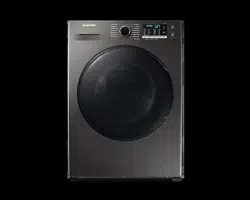Documents: Go to download!
User Manual
- Owner's manual - (English)
- Quick Guide - (English)
- What’s included
- Before you start
- Operations
- Maintenance
- Troubleshooting
Table of contents
Owner's Guide Washing & Dryer
What’s included
Make sure all the parts are included in the product package. If you have a problem with the washing machine or the parts, contact a local Samsung customer centre or the retailer.

- Release lever
- Detergent drawer
- Control panel
- Door
- Drum
- Lint filter
- Emergency drain tube
- Filter cover
- Worktop
- Power plug
- Drain hose
- Levelling feet
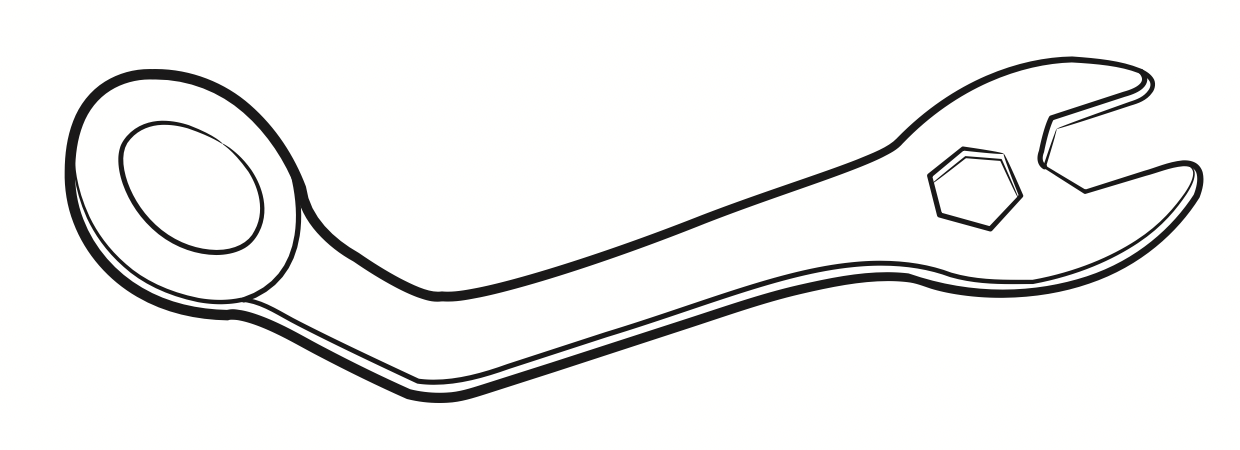
Spanner
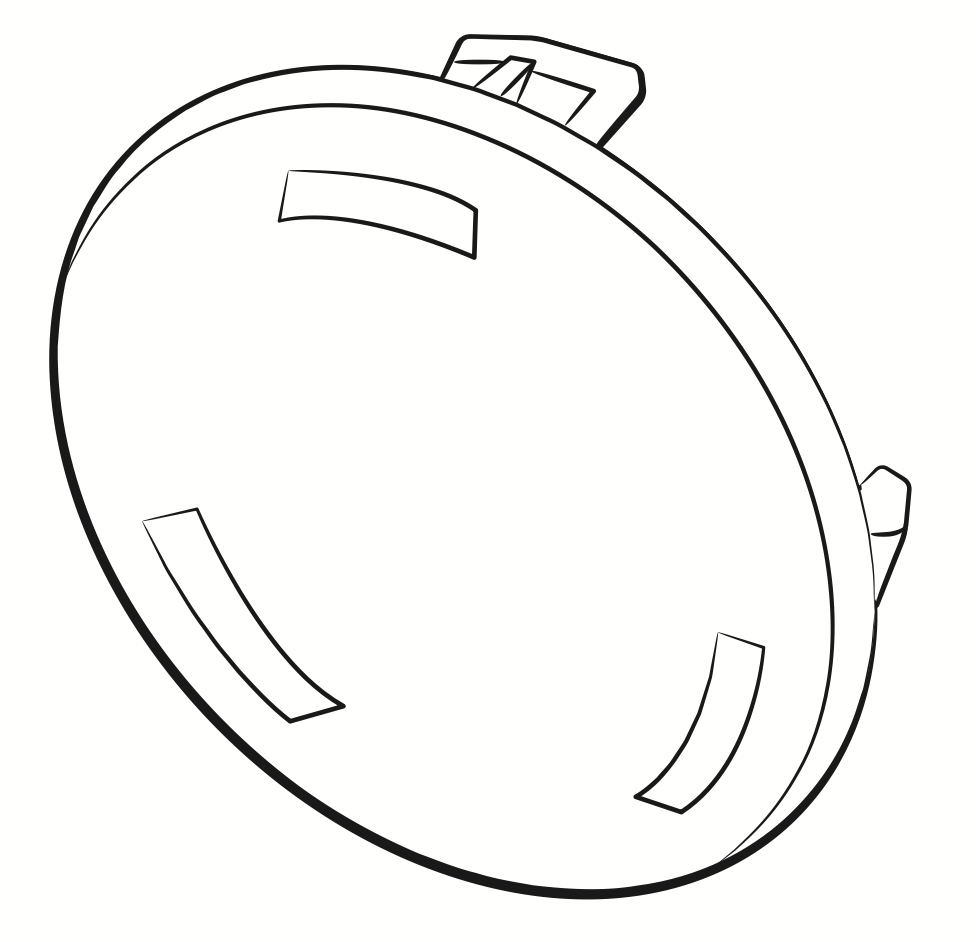
Bolt caps
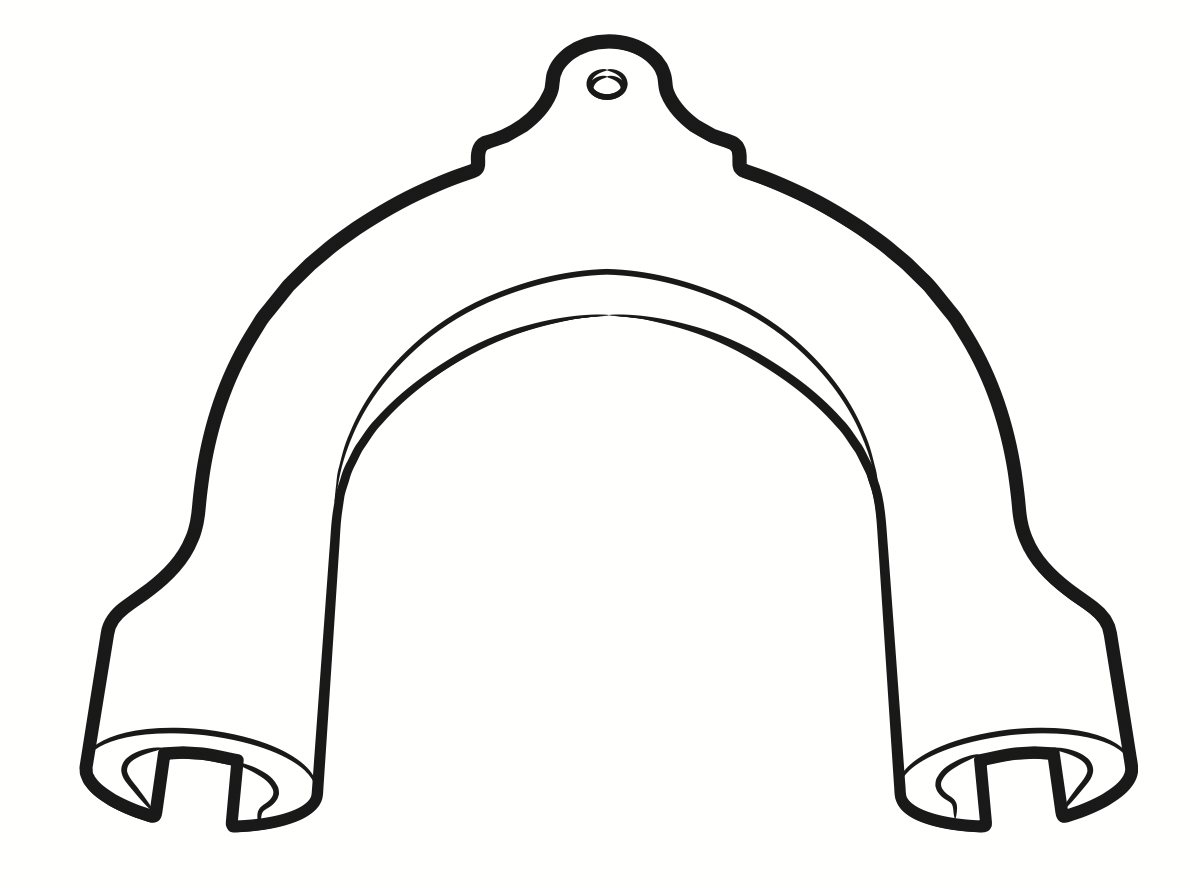
Hose guide
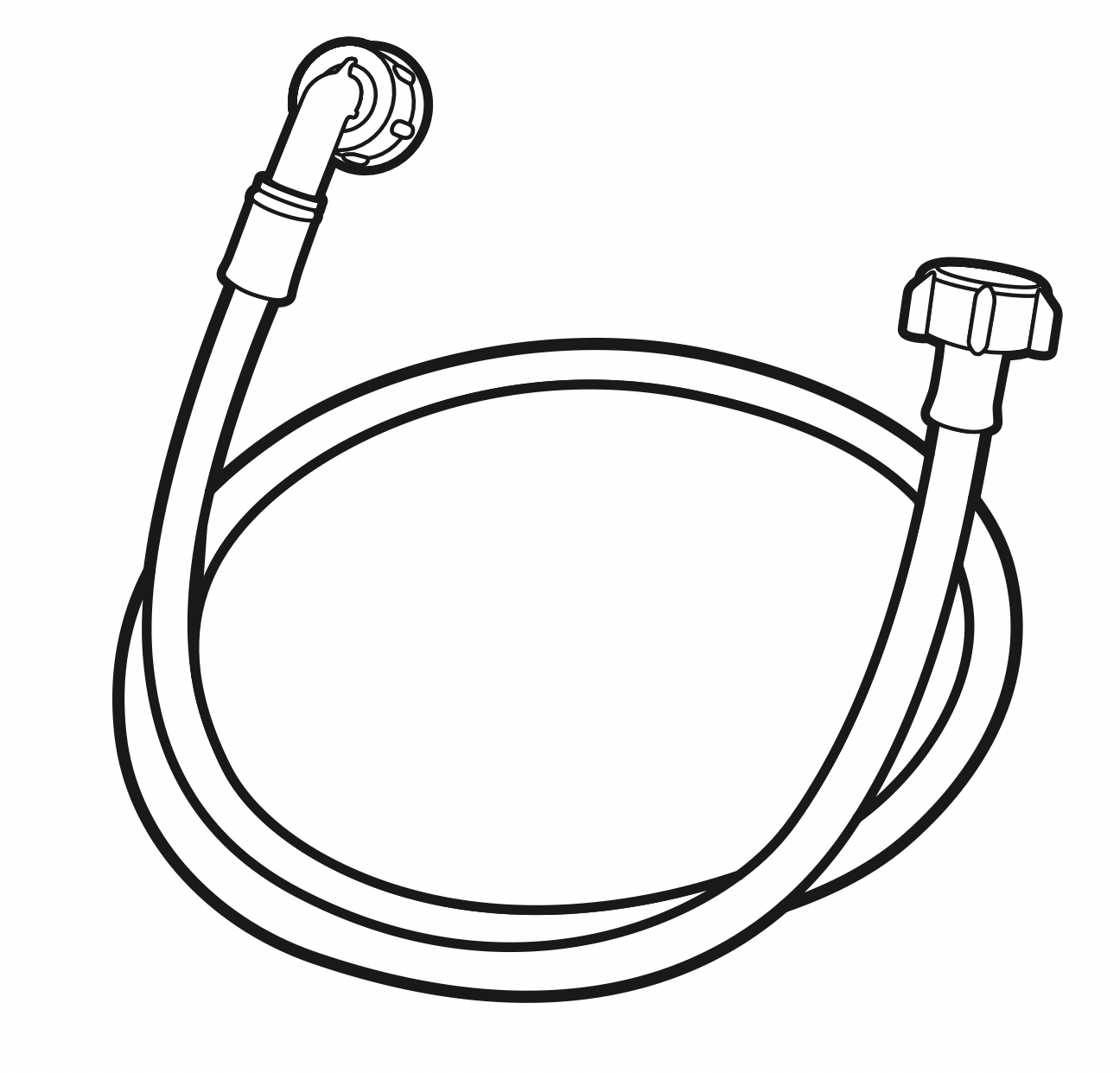
Cold water hose

Hot water hose

Liquid detergent container

Cap fixer
NOTE
- Spanner: For removing the shipping bolts and levelling the washing machine.
- Bolt caps : For covering the holes after removing the shipping bolts. The provided number of bolt caps (3 to 6) depends on the model.
- Hose guide: For hanging the drain hose in the drainpipe or wash-basin.
- Cold/Hot water hose: For supplying water to the washing machine. (Hot water hoses is for applicable models only.)
- Liquid detergent guide: Insert it in the detergent compartment to use liquid detergent. (Applicable models only)
Before you start
Initial settings
Run Calibration (recommended)
Calibration ensures accurate weight detection by the washing machine. Make sure the drum is empty before running Calibration.
- Power off, and then power on the washing machine.
- Hold down
 Temp. and
Temp. and  Delay End simultaneously for 3 seconds to enter Calibration mode. The “CB” message appears.
Delay End simultaneously for 3 seconds to enter Calibration mode. The “CB” message appears. - Press
 Start/Pause to run the Calibration cycle.
Start/Pause to run the Calibration cycle. - The drum will rotate clockwise and counter-clockwise for about 3 minutes.
- When the cycle is complete, “0” appears on the display and the washing machine will turn off automatically.
- The washing machine is now ready for use.
Laundry guidelines
STEP 1: Sort
Sort the laundry according to these criteria:
- Care Label: Sort the laundry into cottons, mixed fibres, synthetics, silks, wools, and rayon.
- Colour: Separate whites from colours.
- Size: Mixing different-sized items together in the drum improves the washing performance.
- Sensitivity: Wash delicate items separately using an Easy Iron option for pure, new woollen items, curtains, and silk items. Check the labels on the items.
NOTE: Make sure to check the care label on the clothing, and sort them accordingly before starting the wash.
STEP 2: Empty pockets
Empty all the pockets of your laundry items
- Metal objects such as coins, pins, and buckles on clothing may damage other laundry items as well as the drum.
Turn clothing with buttons and embroideries inside out
- If pants or jacket zippers are open while washing, the drum may be damaged. Zippers should be closed and fixed with a string.
- Clothing with long strings may become entangled with other clothes. Make sure to tie the strings before starting the wash.
STEP 3: Use a laundry net
- Brassieres (water washable) must be placed in a laundry net. Metal parts of the brassieres may break through and tear other laundry items.
- Small, light clothing such as socks, gloves, stockings, and handkerchiefs may become caught around the door. Place them inside a fine laundry net.
- Do not wash the laundry net by itself without other laundry. This may cause abnormal vibrations that could move the washing machine and result in injury.
STEP 4: Prewash (if necessary)
Select the Prewash option for the selected cycle if the laundry is heavily soiled. Do not use the Prewash option when detergent is manually added into the drum.
STEP 5: Determine the load capacity
Do not overload the washing machine. Overloading may cause the washing machine to not wash properly. For the load capacity for the type of clothing, see page 40.
NOTE: When washing bedding or bedding covers, the wash time may be lengthened or the spin efficiency may be reduced. For bedding or bedding covers, the recommended maximum spin cycle speed is 800 rpm, and the load capacity is 2.0 kg or less.
CAUTION
- Unbalanced laundry may reduce the spinning performance.
- Make sure the laundry is fully inserted in the drum and not caught in the door.
- Do not slam the door. Close the door gently. Otherwise, the door may not be closed properly.
STEP 6: Apply a proper detergent type
The type of detergent depends on the type of fabric (cotton, synthetic, delicate items, wool), colour, wash temperature, and degree of soiling. Always use “low suds” laundry detergent, which is designed for automatic washing machines.
NOTE
- Follow the detergent manufacturer’s recommendations based on the weight of the laundry, the degree of soiling, and the hardness of the water in your local area. If you are not sure about the water hardness, contact a local water authority.
- Do not use detergent that tends to be hardened or solidified. This detergent may remain after the rinse cycle, blocking the drain outlet.
CAUTION: When washing wool using the WOOL/DELICATES cycle, use only a neutral liquid detergent. If used with the WOOL/DELICATES cycle, powder detergent may remain on the laundry and discolour the laundry.
Laundry capsules
To get the best results from using laundry capsules, please follow these instructions.
- Put the capsule in the bottom of the empty drum towards the rear.
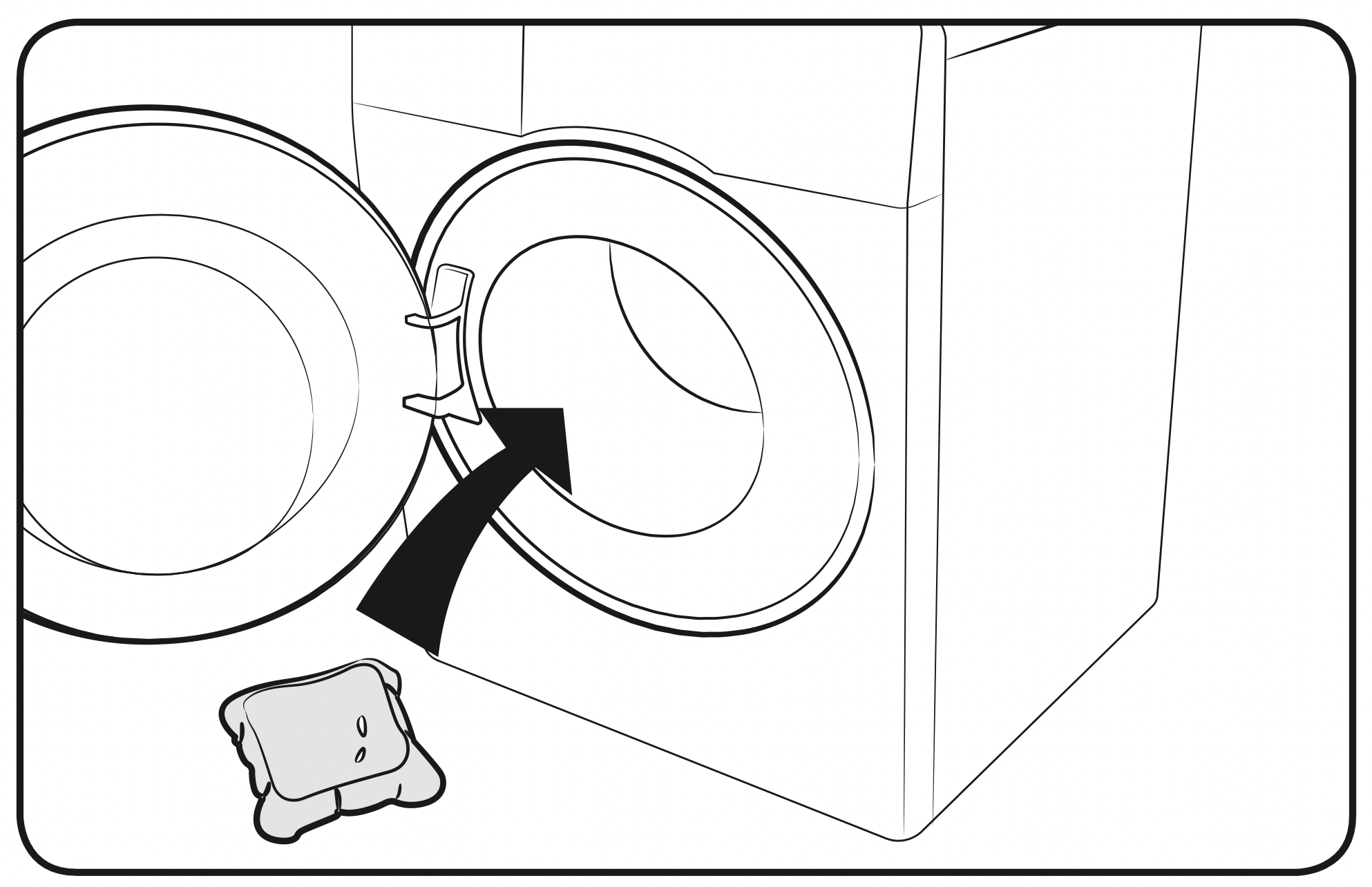
- Put the laundry in the drum on top of the capsule.
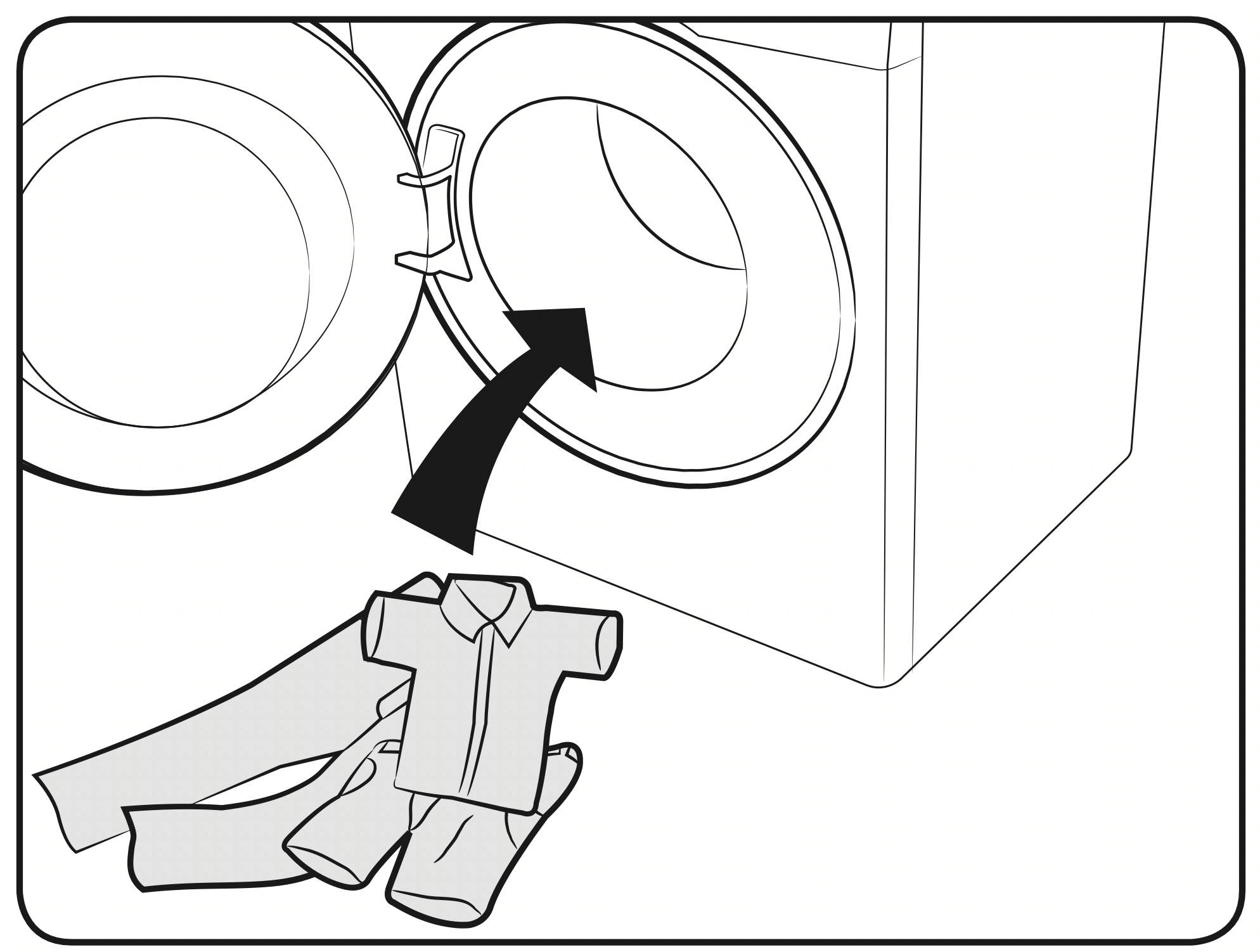
CAUTION: For cycles using cold water or cycles that complete in less than one hour, the capsule may not dissolve completely.
Detergent recommendation
The recommendations apply to the temperature ranges given in the cycle chart.

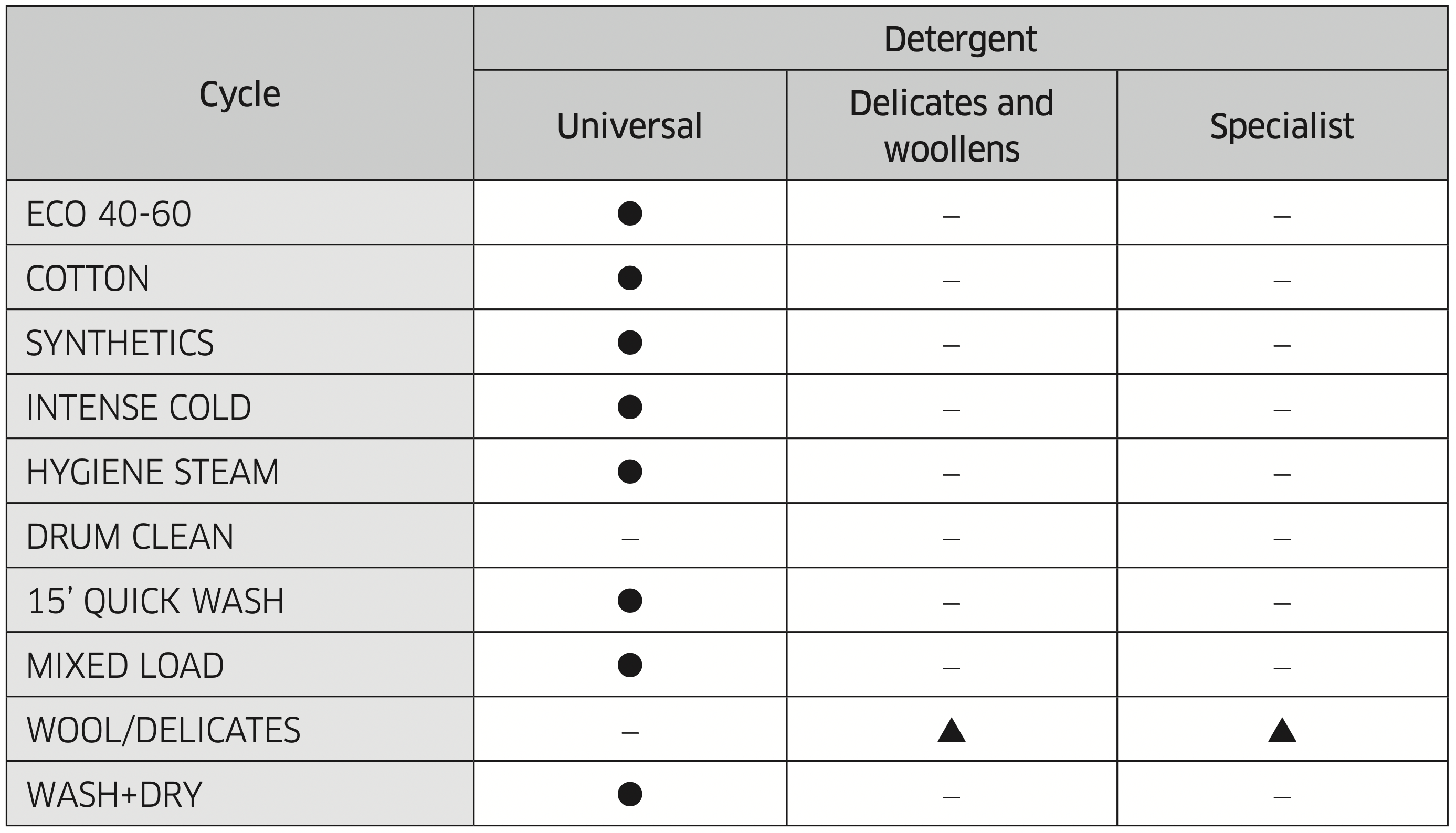
Detergent drawer guidelines
The washing machine provides a three-compartment dispenser: the left compartment for the main wash, the centre compartment for fabric softeners, and the right compartment for the preliminary wash.
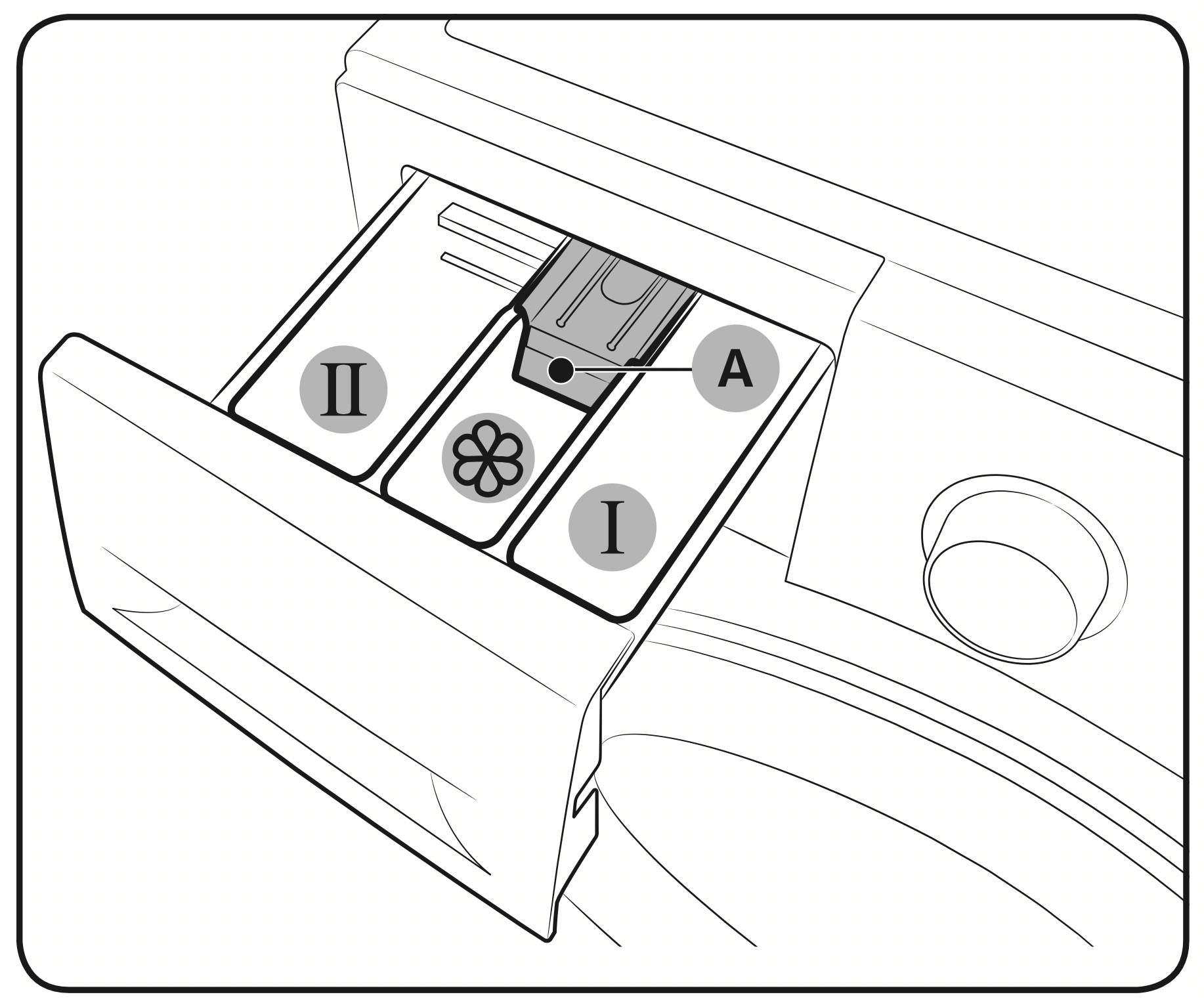
 Prewash compartment: Apply prewash detergent.
Prewash compartment: Apply prewash detergent. Main-wash compartment: Apply main-wash detergent, water softener, soaking detergent, bleach, and/or stain removers.
Main-wash compartment: Apply main-wash detergent, water softener, soaking detergent, bleach, and/or stain removers. Softener compartment: Apply additives such as fabric softener. Do not exceed the max line (A).
Softener compartment: Apply additives such as fabric softener. Do not exceed the max line (A).
CAUTION:
- Do not open the detergent drawer while the washing machine is operating.
- Do not use the following types of detergent:
- Tablet or capsule types
- Ball or net types
- To prevent the compartment clogging, concentrated or highly-enriched agents (fabric softener or detergent) must be diluted with water before being applied.
- When Delay End is selected, do not apply detergent directly into the drum. Otherwise, this may discolour the laundry. Use the detergent drawer when Delay End is selected.
- Do not use any cleaning agents for cleaning the drum. Chemical residue in the drum deteriorates the washing performance.
To apply washing agents to the detergent drawer
- Slide open the detergent drawer.
- Apply laundry detergent to the
 . main-wash compartment as instructed or recommended by the manufacturer. To use liquid detergent, see page 36.
. main-wash compartment as instructed or recommended by the manufacturer. To use liquid detergent, see page 36.
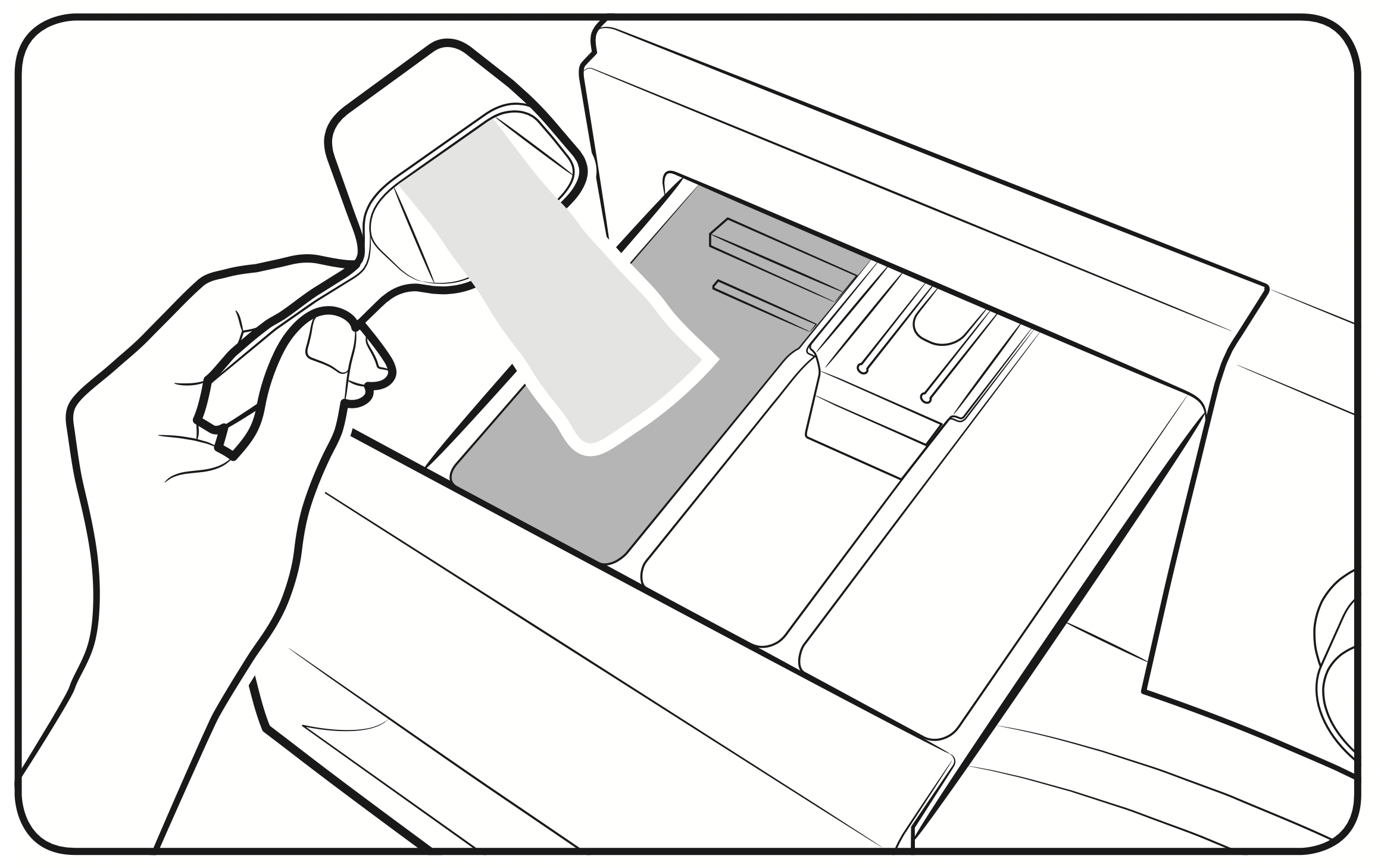
- Apply fabric softener to the
 softener compartment. Do not exceed the max line (A).
softener compartment. Do not exceed the max line (A).

- If you want to prewash, apply prewash detergent to the
 prewash compartment as instructed or recommended by the manufacturer.
prewash compartment as instructed or recommended by the manufacturer. - Close the detergent drawer.
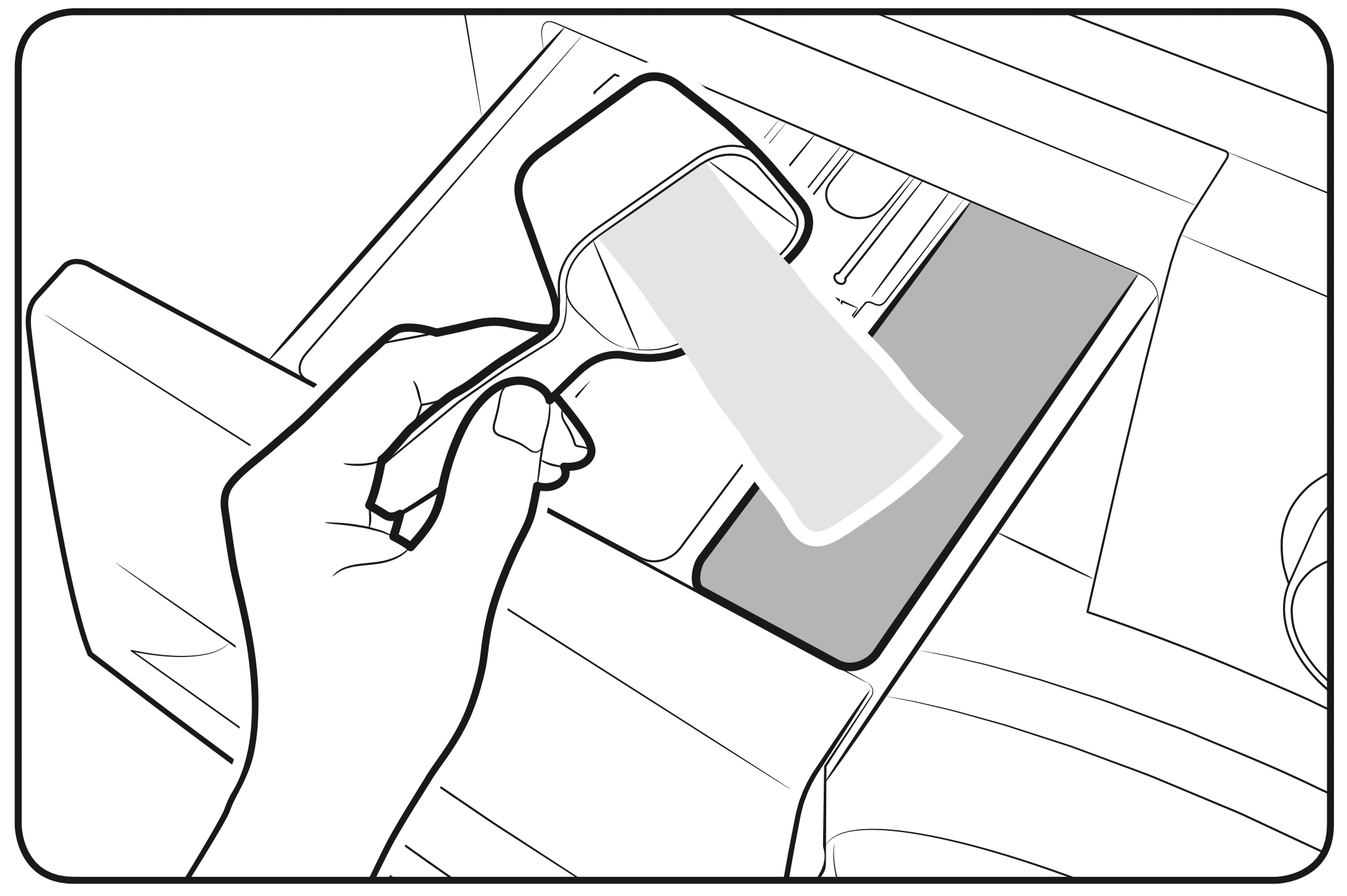
CAUTION
- Do not apply powder detergent to the liquid container.
- Concentrated fabric softener must be diluted with water before applied.
- Do not apply main-wash detergent to the
 softener compartment.
softener compartment.

To use liquid detergent (applicable models only)
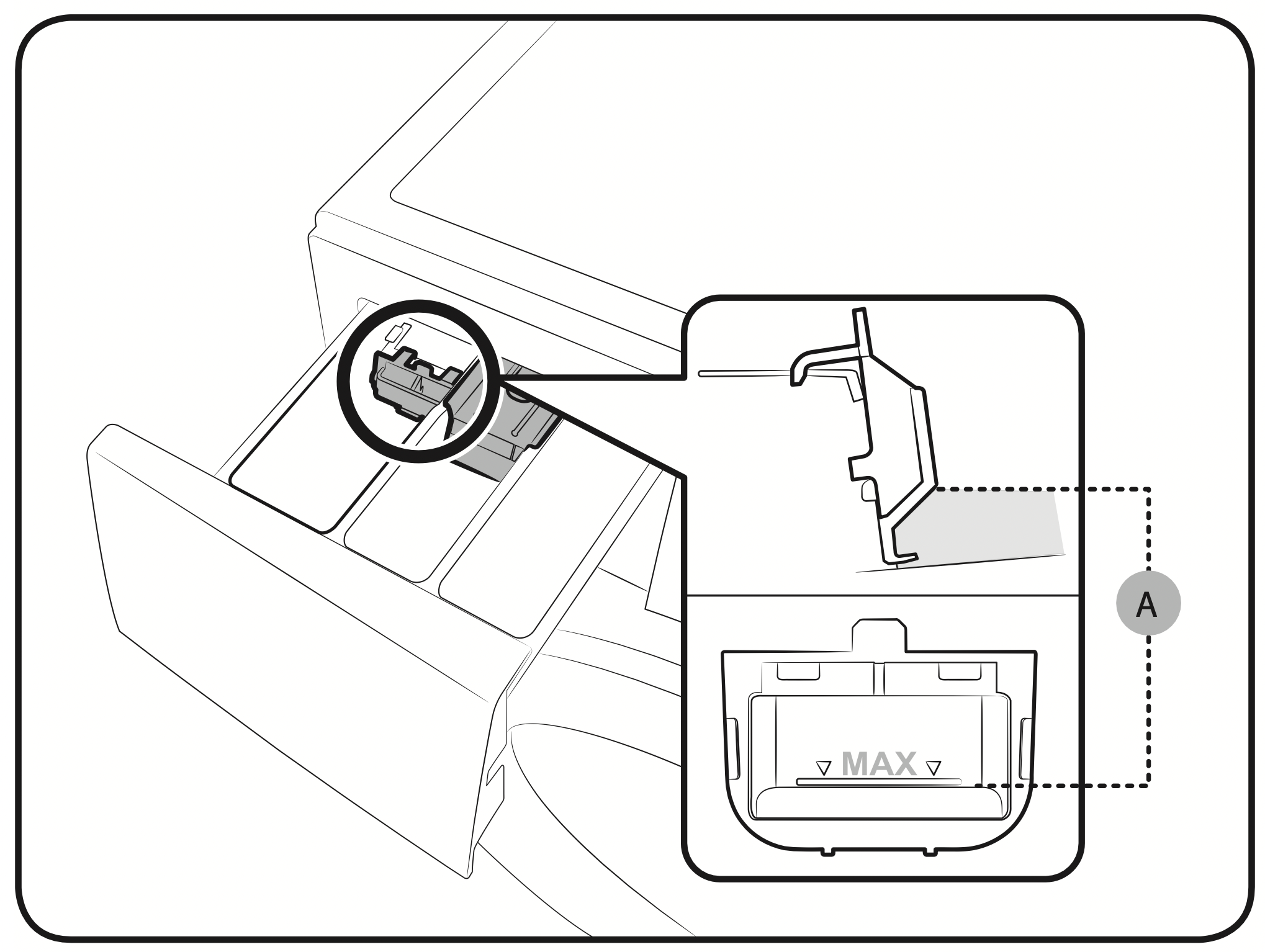
First insert the provided liquid container in the  main-wash compartment. Then, apply liquid detergent to the container below the marked max line (A).
main-wash compartment. Then, apply liquid detergent to the container below the marked max line (A).
CAUTION
- Do not exceed the max line that is marked inside the container.
- Turn up the liquid container if using powder detergent.
When using liquid detergent
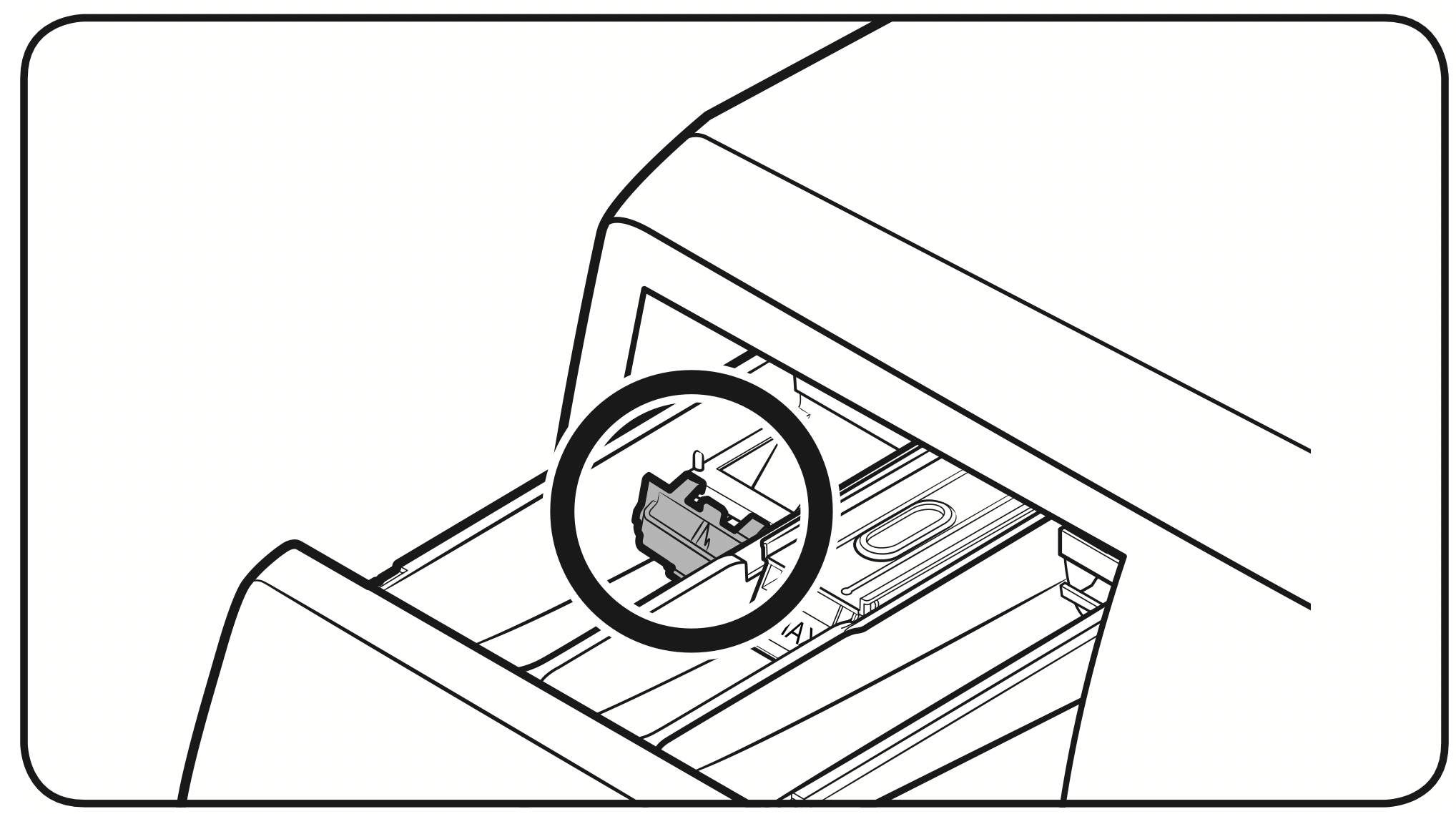
When using powder detergent
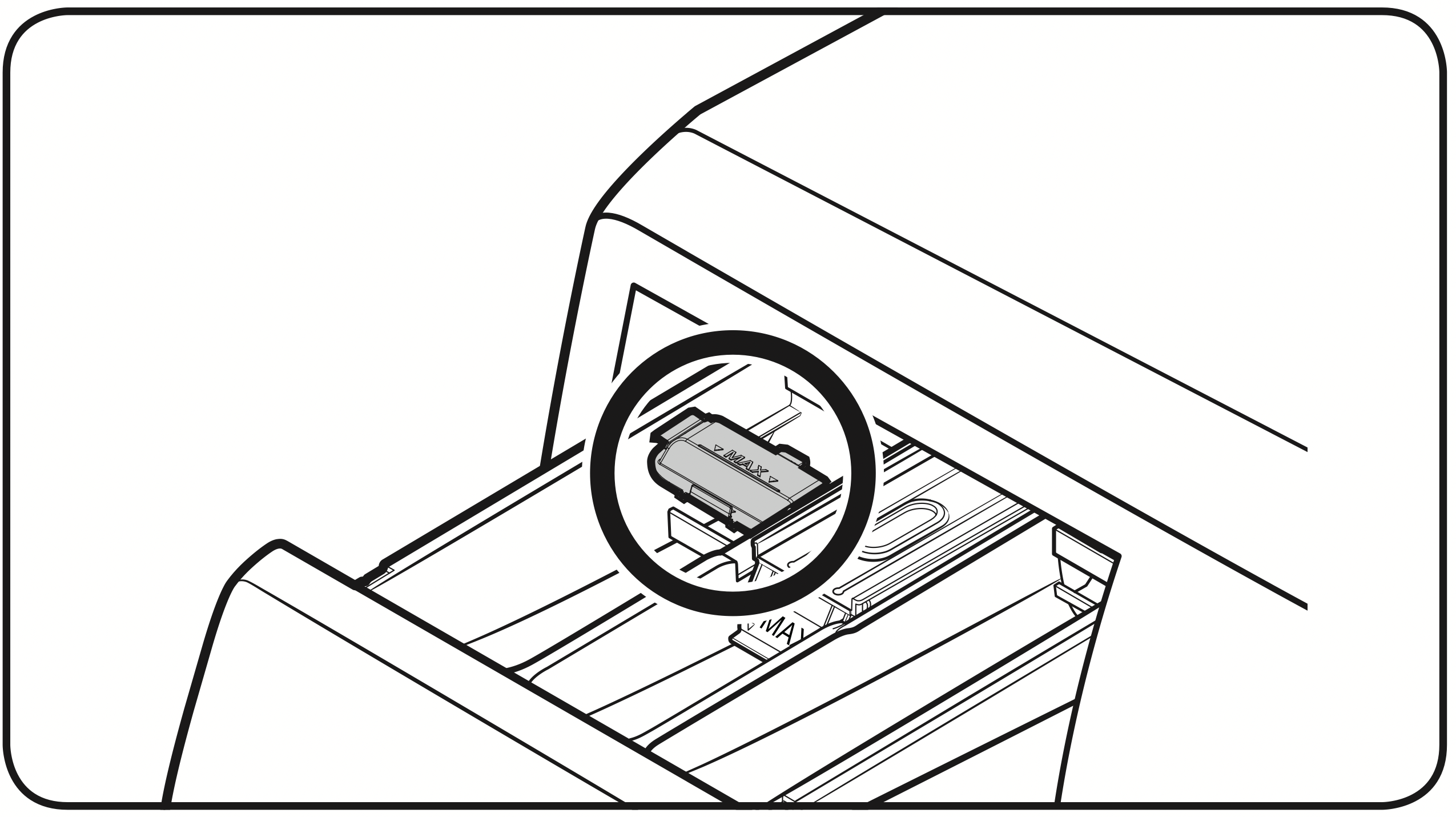
Operations
Control panel


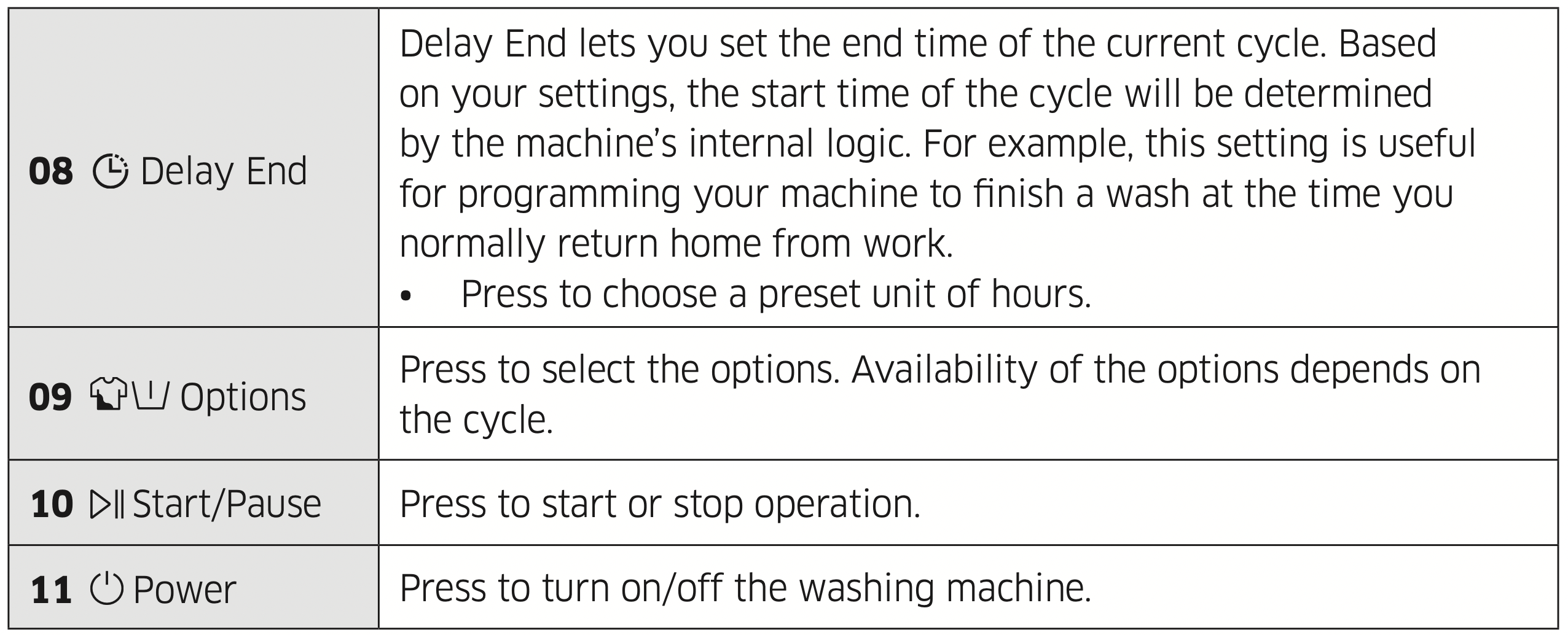
For more information on the options, see the Special features section.
*(3 sec) : Press and hold for 3 seconds.
Simple steps to start

- Press
 Power to turn on the washing machine.
Power to turn on the washing machine. - Turn the Cycle Selector to select a cycle.
- Change the cycle settings (
 Temp.,
Temp.,  Rinse and
Rinse and  Spin ) as necessary.
Spin ) as necessary. - Press
 Options,
Options,  Bubble Soak or
Bubble Soak or  Dry Option to add desired options. Available options differ depending on the selected cycle.
Dry Option to add desired options. Available options differ depending on the selected cycle. - The machine provides one easy to access buttons for
 Delay End for your convenience.
Delay End for your convenience.
See other models: QA55LST7TAWXXY SM-M317FZKNEUA SM-T870NZKEXAC SM-T978UZKAUSC RB34T602EWW/EU
If you want to use the option, press the corresponding button. - Press
 Start/Pause.
Start/Pause.
Drying Only
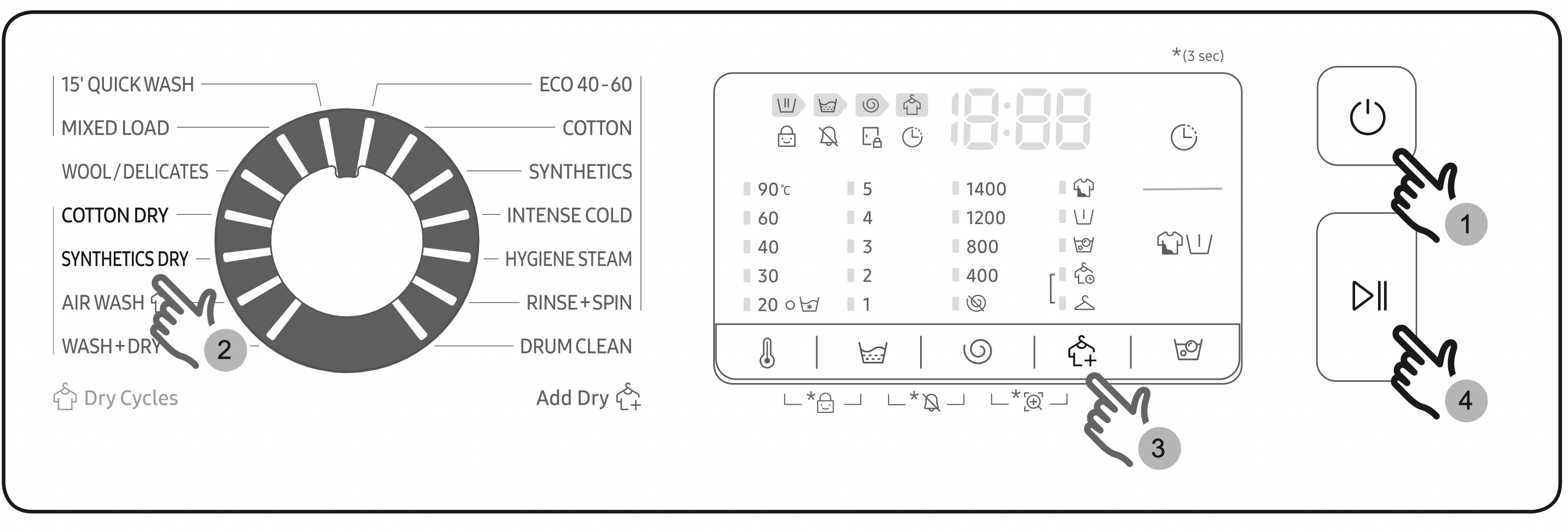
You can dry your clothes directly or dry the washed clothes according to the following procedures.
- Press
 Power button to turn on the washing machine.
Power button to turn on the washing machine. - Turn the Cycle Selector to select the appropriate drying cycle.
- Press
 Dry Option button to select the appropriate drying mode.
Dry Option button to select the appropriate drying mode. - Press
 Start/Pause button to start dry.
Start/Pause button to start dry.
To change the cycle during operation
- Press Start/Pause to stop operation.
- Select a different cycle.
- Press Start/Pause again to start the new cycle.
Cycle overview
Standard ccycles
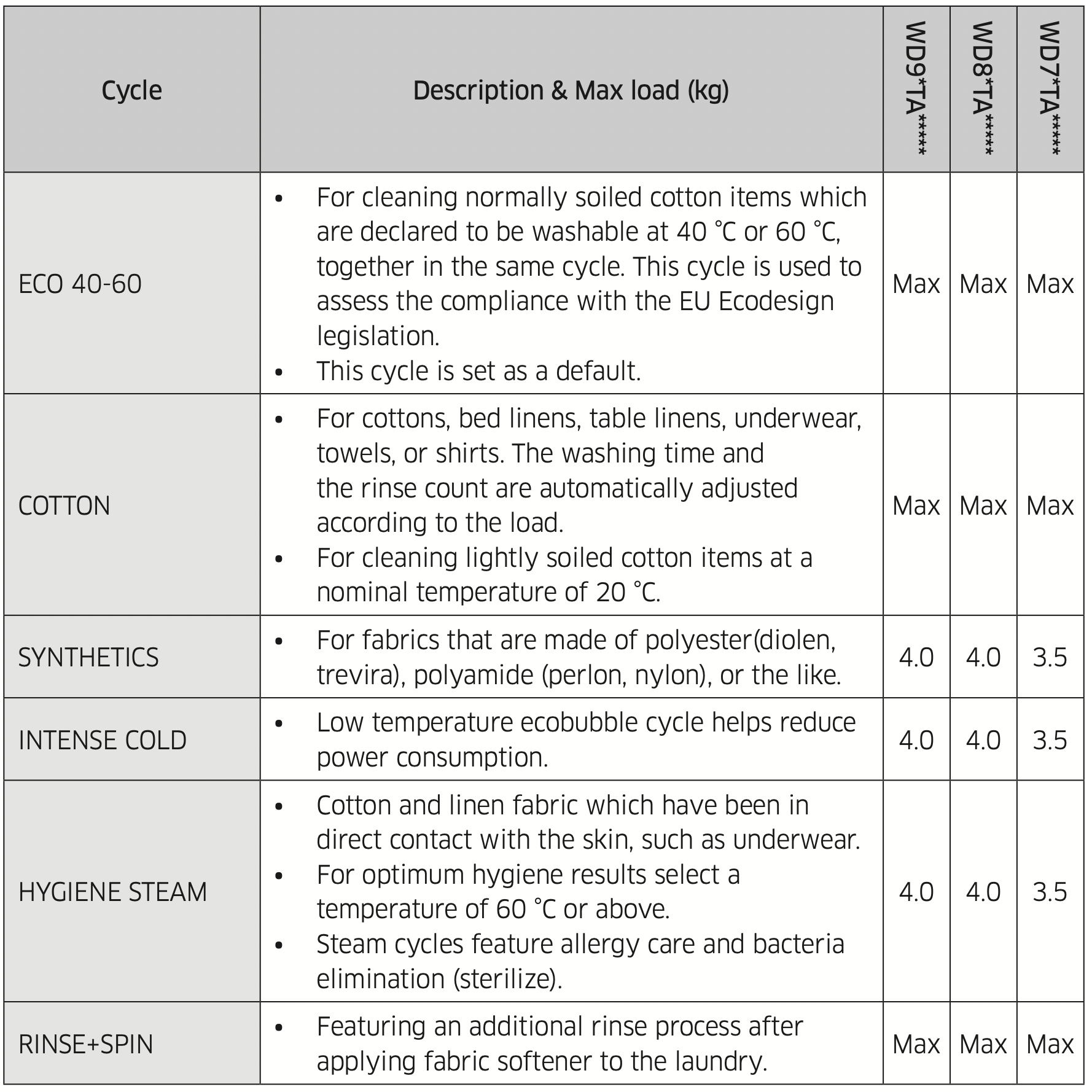
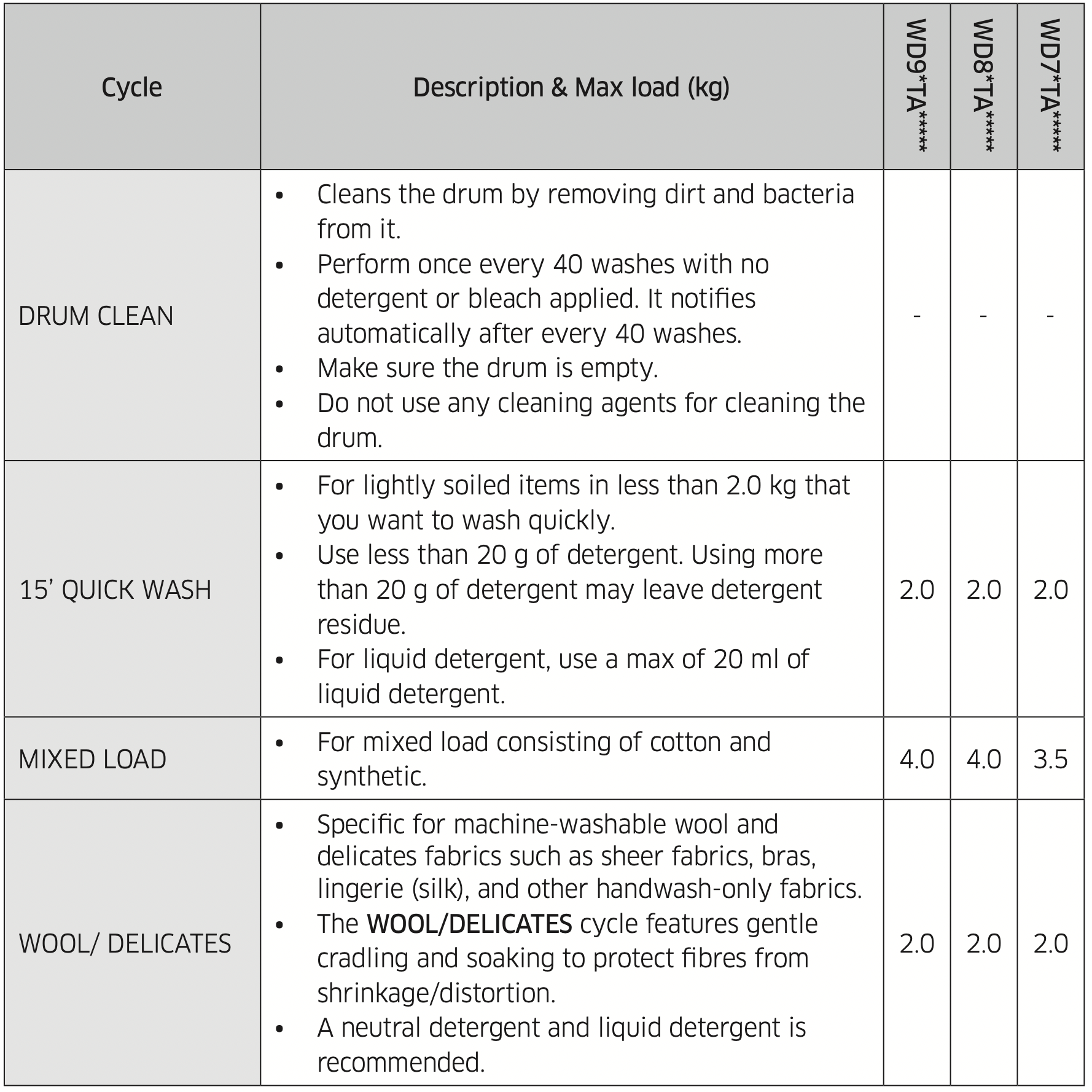
 Dry cycles
Dry cycles
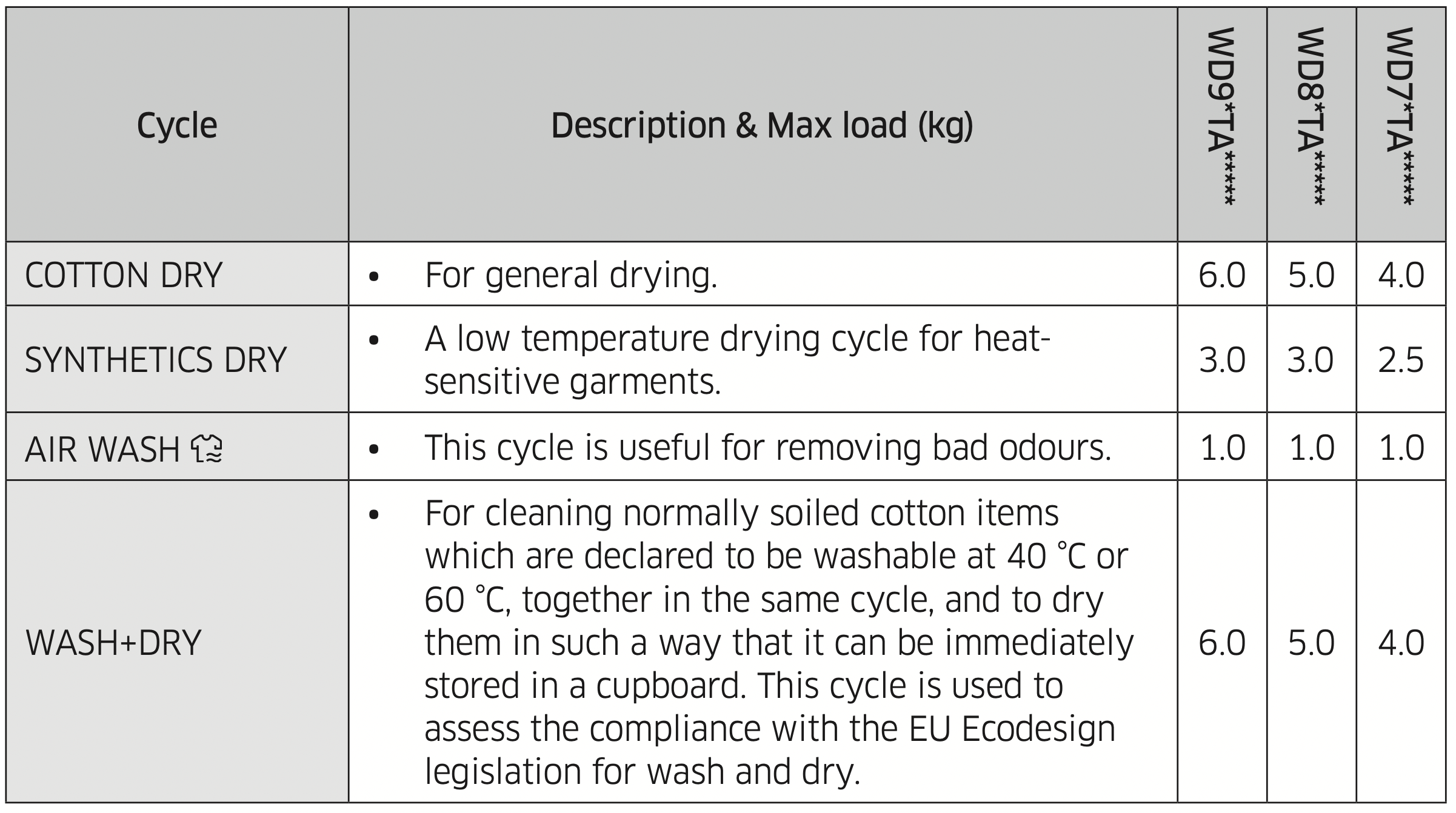
NOTE
- Loading the household washing machine or the household washer-dryer up to the capacity indicated by the manufacturer for the respective cycles will contribute to energy and water savings.
- The noise and remaining moisture content are influenced by the spinning speed: the higher the spinning speed in the spinning phase, the higher the noise and the lower the remaining moisture content.
- The most efficient cycle in terms of energy consumption are generally those that perform at lower temperatures and longer duration.
Options


 Dry Option
Dry Option

Delay End 
You can set the washing machine to finish your wash automatically at a later time, choosing a delay of between 1 to 24 hours (in 1 hour increments). The hour displayed indicates the time the wash will finish.
- Select a cycle. Then change the cycle settings if necessary.
- Press Delay End repeatedly until a desired end time is set.
- Press Start/Pause.
The corresponding indicator turns on with the clock running. - To cancel the Delay End, restart the washing machine by pressing Power.
Real-life case
You want to finish a two-hour cycle 3 hours later from now. For this, you add the Delay End option to the current cycle with the 3-hour setting, and press Start/Pause at 2:00 p.m. Then, what happens? The washing machine starts operating at 3:00 p.m., and ends at 5:00 p.m. Provided below is the time line for this example.

Settings
Child Lock 
To prevent children or infants from accidentally starting or setting the washing machine, Child Lock locks all buttons except for the Power button.
- To set the Child Lock function, hold down
 Temp. and
Temp. and  Rinse simultaneously for 3 seconds. To activate, press
Rinse simultaneously for 3 seconds. To activate, press  Start/ Pause.
Start/ Pause. - To release the Child Lock function, hold down
 Temp. and
Temp. and  Rinse simultaneously for 3 seconds.
Rinse simultaneously for 3 seconds.
NOTE
- In the Child Lock state, you must first release the Child Lock if you want to add detergent or laundry.
- Your setting will be kept even after restarting the machine.
- You cannot open the door after a wash cycle when the Child Lock is on. Turn the function off before opening the door to take out the laundry.
Sound On/Off 
You can turn on or off the sound from the washing machine. When this function is set to Off, the melody of cycle completion, and the power-off beep will not sound. However, the other sounds stay active.
- To mute the sound, hold down
 Rinse and
Rinse and  Spin simultaneously for 3 seconds.
Spin simultaneously for 3 seconds. - To unmute the sound, hold down again for 3 seconds.
- Your setting will be kept even after restarting the machine.
Maintenance
Keep the washing machine clean to prevent deteriorated performance and to preserve its life cycle.
Drum clean
Perform this cycle regularly to clean the drum by removing bacteria from it. This cycle heats the water between 60 °C and 70 °C, and it also removes accumulated dirt from the rubber door gasket.
- Press Power to turn on the washing machine.
- Turn the Cycle Selector to select DRUM CLEAN.
- Press Start/Pause.
NOTE
- The water temperature for DRUM CLEAN is set to 70 °C, which cannot be changed.
- It is recommended to run the DRUM CLEAN cycle once every 40 washes.
- To prevent limescale, add the proper amount of detergent according to your local water hardness or add a water softener additive together with the detergent.
DRUM CLEAN reminder
Depending on the model, the DRUM CLEAN reminder is either an icon or an LED.
For icons, the icon lights up on the control panel.
For LEDs, the LED lights up next to DRUM CLEAN, or on the option area of the control panel.
- The DRUM CLEAN reminder blinks on the control panel once every 40 washes. It is advisable to perform DRUM CLEAN regularly.
- When you first see this reminder blinking, you can ignore the reminder for 6 consecutive washes. From the 7 th wash, the reminder no longer appears. However, it appears again on the second 40 th wash.
- Even after the last process is terminated, the “0” message may remain.
- You can record the running count of the DRUM CLEAN cycle by pressing the Power button. This does not stop or turn off the machine but marks your cycle count.
- Even if “0” does not disappear, the machine operates normally.
- It is recommended to run the cycle regularly for hygienic purposes.
Smart check 
To enable this function, you must first download the Samsung Smart Washer app at the Play Store or the Apple Store, and install it on a mobile device featuring a camera function.
The Smart Check function has been optimized for Galaxy & iPhone series (applicable models only).
- When the washing machine detects an issue to check, an information code appears on the display. To enter Smart Check mode, press and hold
 Spin and
Spin and  Dry Option simultaneously for 3 seconds.
Dry Option simultaneously for 3 seconds. - The washing machine starts the self-diagnosis procedure and displays an information code if a problem is detected.
- Run the Samsung Smart Washer app on your mobile device, and tap Smart Check.
- Put the mobile device close to the washing machine’s display so that the smartphone camera and the washing machine face each other. Then, the information code will be recognised automatically by the app.
- When the information code is recognised correctly, the app provides detailed information about the problem with applicable solutions.
NOTE
- The function name, Smart Check, may differ depending on the language.
- If the washing machine reflets light on the display, the app may fail to recognize the information code.
- If the app fails to recognize the Smart Check code consecutively, enter the information code manually onto the app screen.
Emergency drain
In case of a power failure, drain the water inside the drum before taking out the laundry.
- Power off and unplug the washing machine from the electrical outlet.
- Gently press the top area of the filter cover (A) to open.
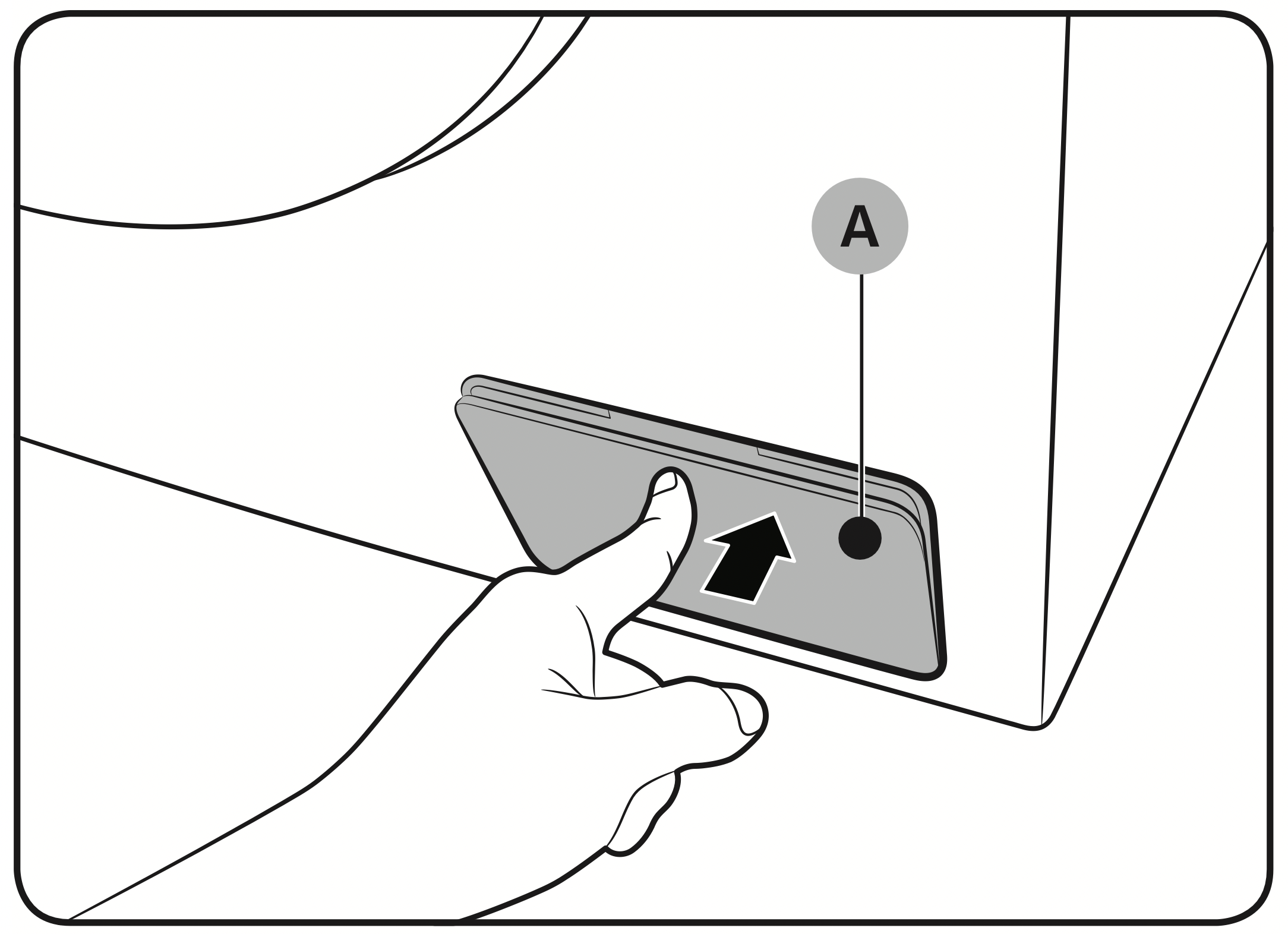
- Put an empty, spacious container around the cover, and stretch the emergency drain tube to the container while holding the tube cap (B).
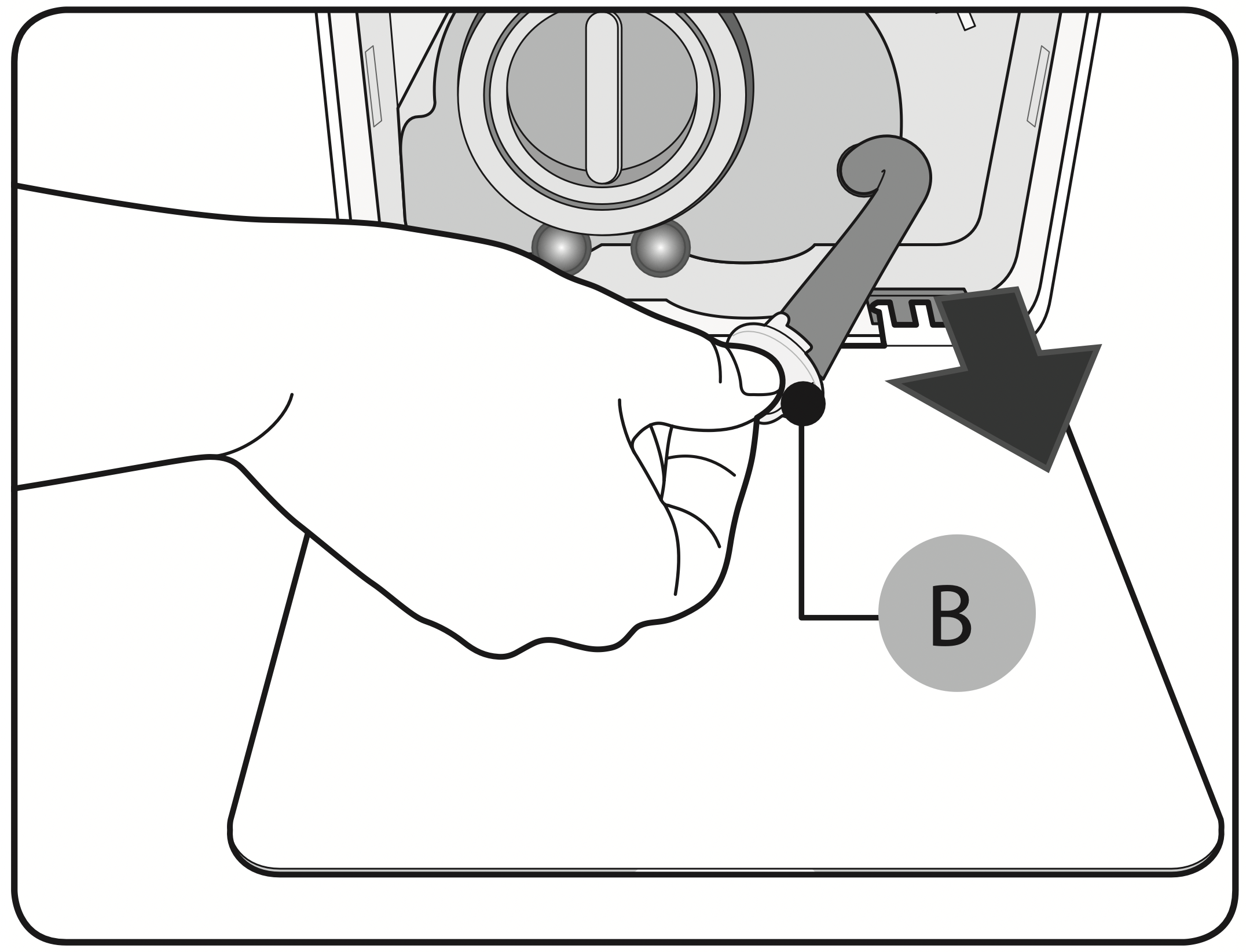
- Open the tube cap and let water in the Emergency drain tube (C) flow into the container.
- When done, close the tube cap, and reinsert the tube. Then, close the filter cover.
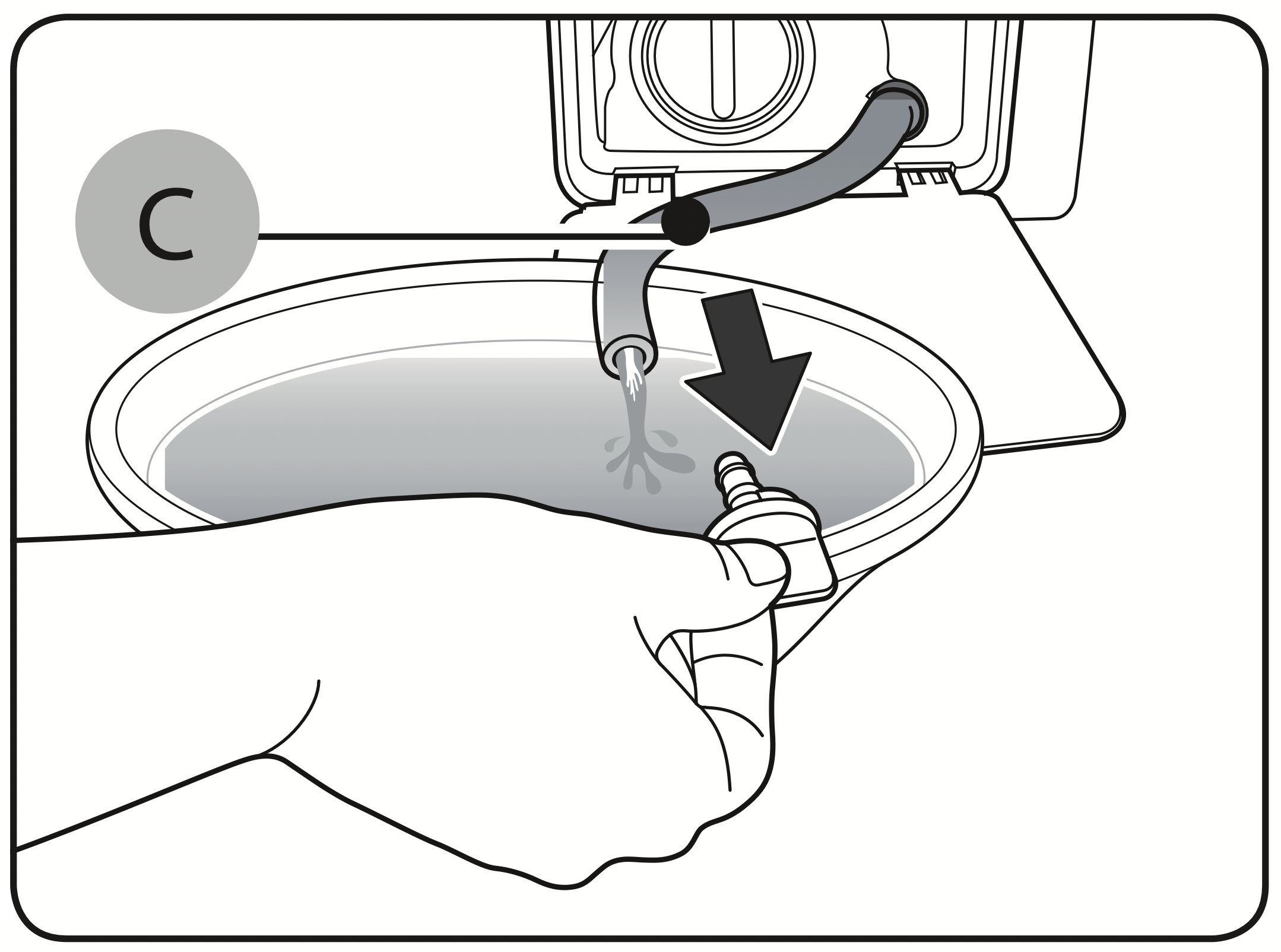
NOTE: Use a spacious container because the water in the drum may be more than expected.
Cleaning
Surface of the washing machine
Use a soft cloth with a nonabrasive household detergent. Do not spray water onto the washing machine.
Mesh filter
Clean the mesh filter of the water hose once or twice a year.
- Turn off the washing machine, and unplug the power cord.
- Close the water tap.
- Loosen and disconnect the water hose from the back of the washing machine. Cover the hose with a cloth to prevent water from gushing out.

- Use pliers to pull out the mesh filter from the inlet valve.
- Submerge the mesh filter deeply in water so that the threaded connector is also submerged.
- Dry the mesh filter completely in the shade.
- Reinsert the mesh filter into the inlet valve, and reconnect the water hose to the inlet valve.
- Open the water tap.
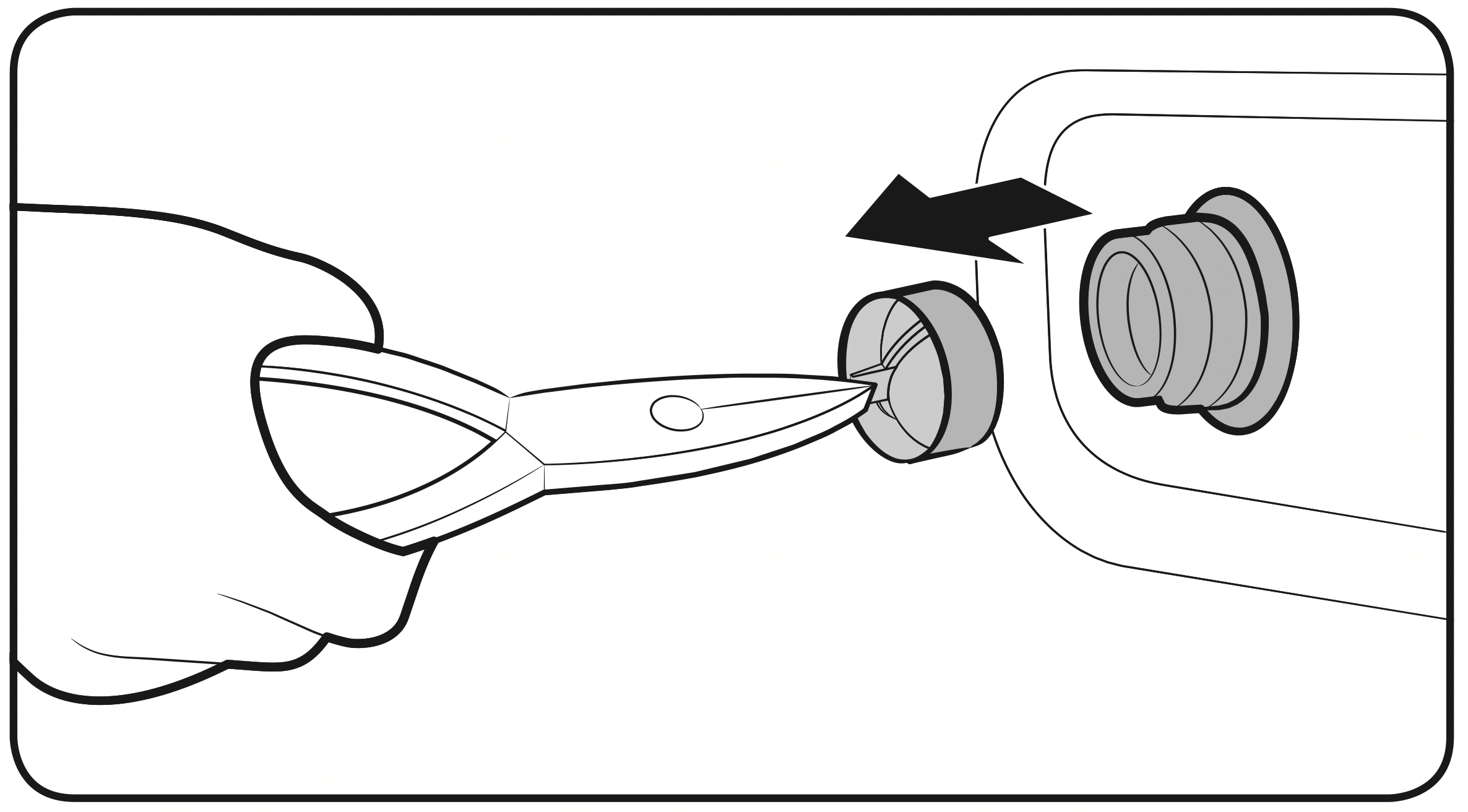
NOTE: If the mesh filter is clogged, an information code of “4C” appears on the screen.
Debris filter
Clean the debris filter bi-monthly to prevent clogging. A clogged debris filter may reduce the bubble effect.
- Turn off the washing machine, and unplug the power cord.
- Drain the remaining water inside the drum. See the “Emergency drain” section.
- Gently press the top area of the filter cover to open.
- Turn the debris filter knob to the left, and drain off the remaining water.
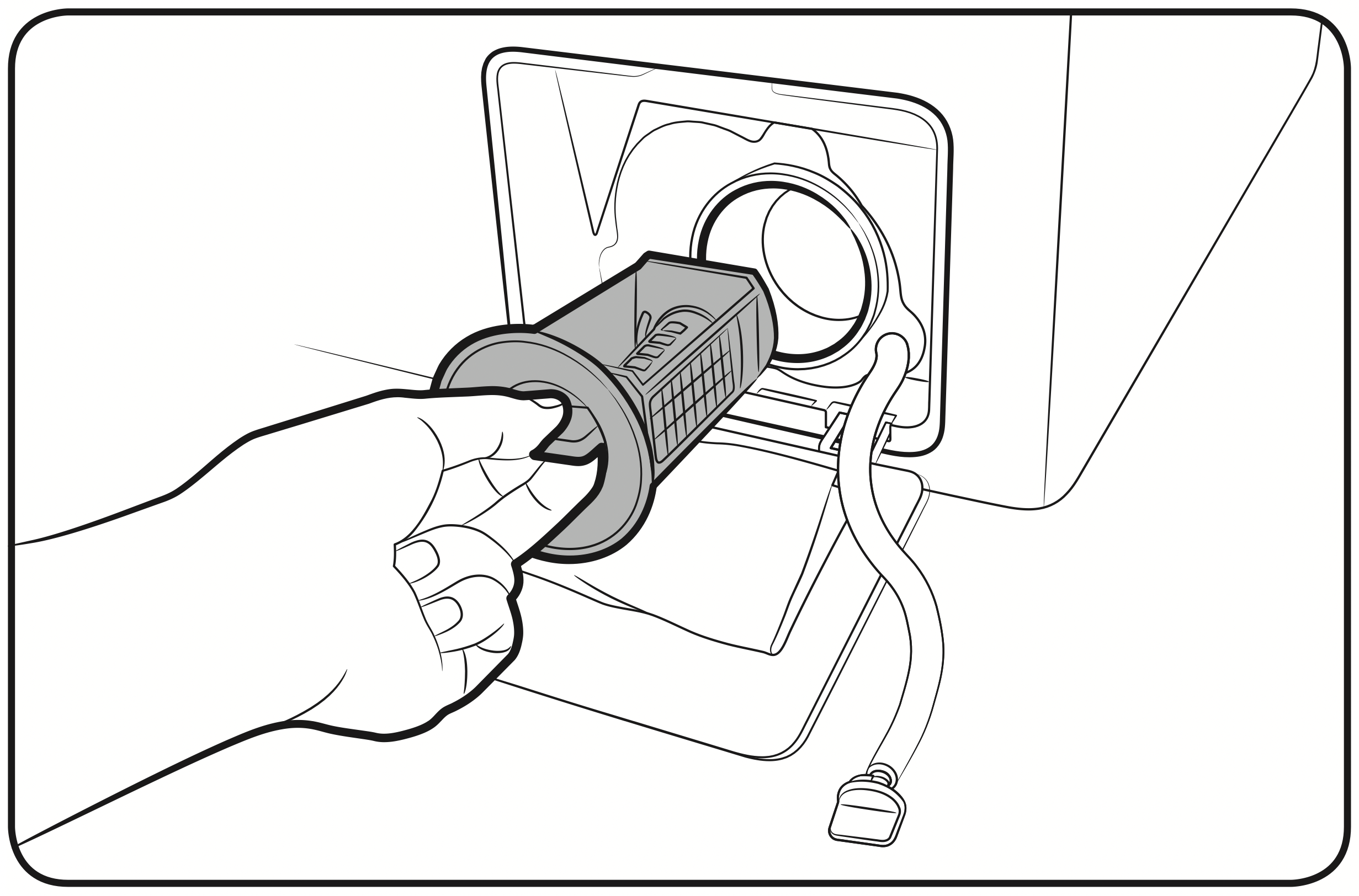
- Clean the debris filter using soft brushes.
Make sure the drain pump propeller inside the filter is unclogged. - Reinsert the debris filter, and turn the filter knob to the right.

NOTE
- Some debris filters feature a safety knob that is designed to prevent accidents by children. To open the safety knob of the debris filter, push in and turn it anticlockwise. The spring mechanism of the safety knob helps open the filter.
- To close the safety knob of the debris filter, turn it clockwise. The spring makes a rattling sound, which is normal.

NOTE: If the debris filter is clogged, an information code of “5C” appears on the screen.
CAUTION
- Make sure the filter cap is closed properly after cleaning the filter. Otherwise, this may cause a leak.
- Make sure the filter is inserted properly after cleaning it. Otherwise, this may cause an operational failure or a leak.
Detergent Drawer
- While holding down the release lever (A) on the inner of the drawer, slide open the drawer.
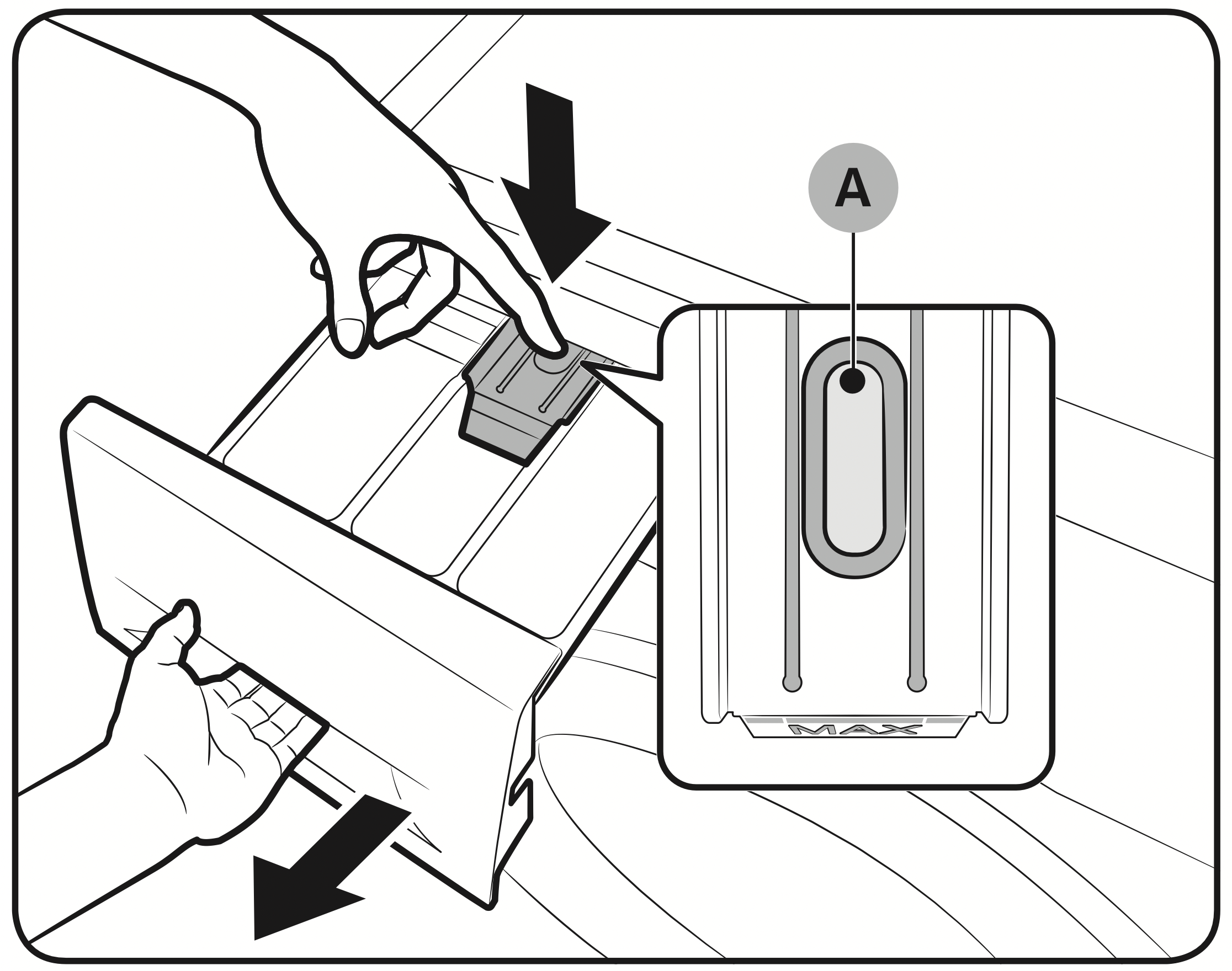
- Clean the drawer components in flowing water using a soft brush.
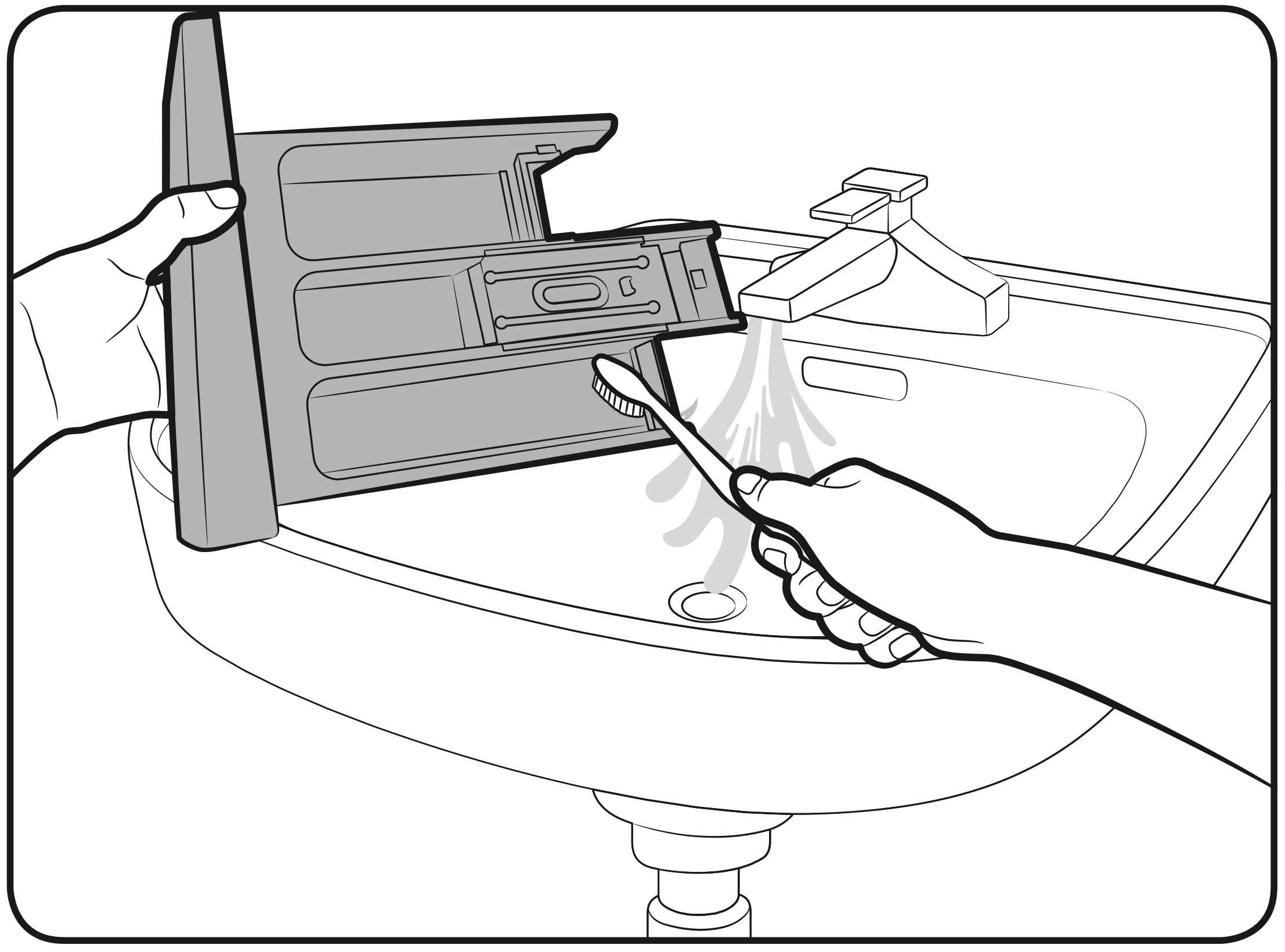
- Clean the drawer recess using a soft brush.
- Reinsert the release lever and the liquid detergent container to the drawer.
- Slide the drawer inward to close it.
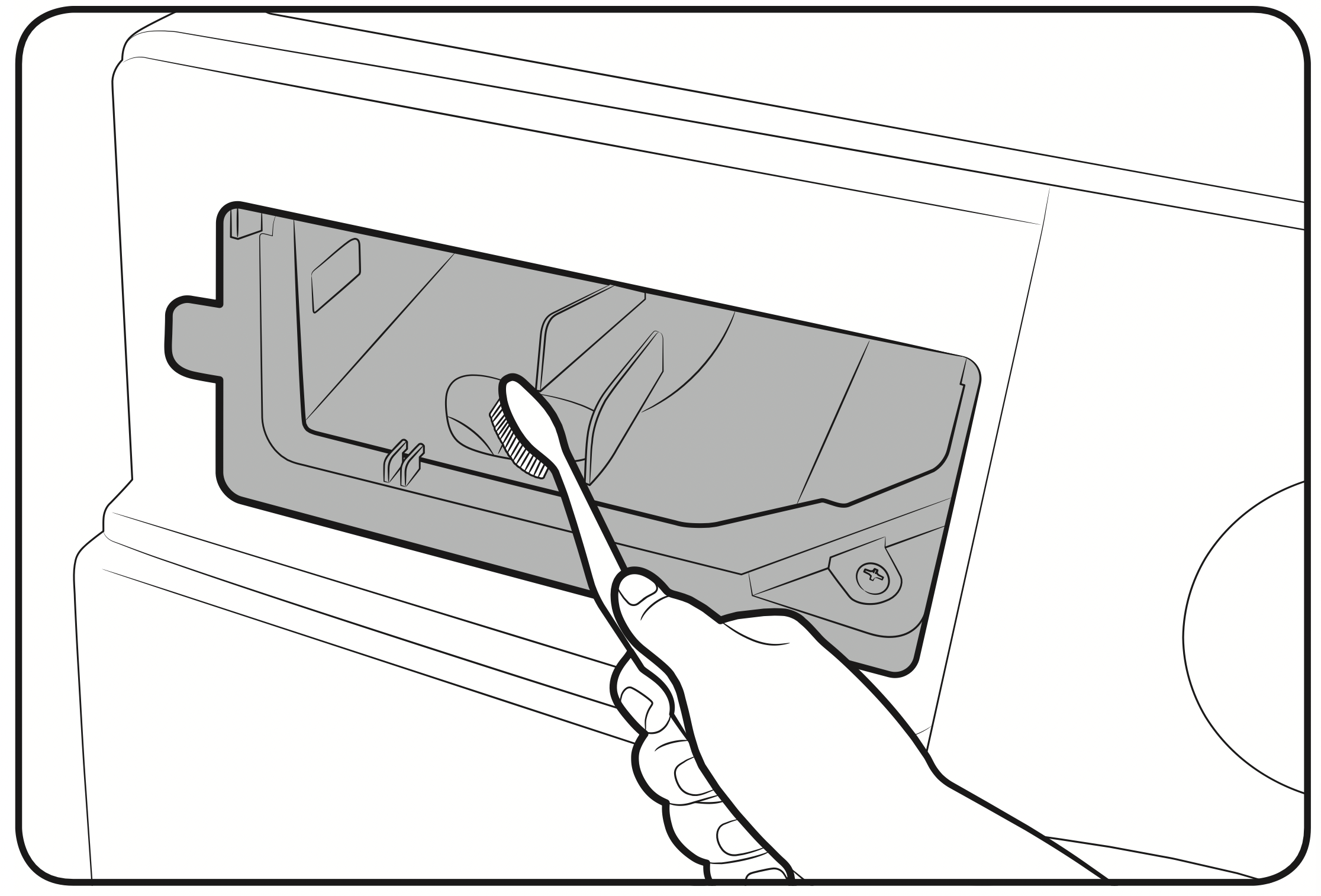
NOTE: To remove remaining detergent, perform the RINSE+SPIN cycle with the drum being empty.
Recovery from freezing
The washing machine may freeze when it drops below 0 °C.
- Turn off the washing machine, and unplug the power cord.
- Pour warm water over the water tap to loosen the water hose.
- Disconnect the water hose, and soak it in warm water.
- Pour warm water into the drum and leave it for about 10 minutes.
- Reconnect the water hose to the water tap.
NOTE: If the washing machine still doesn’t operate normally, repeat the above steps until it operates normally.
Care against an extended time of disuse
Avoid leaving the washing machine unused for an extended time.
If this is the case, drain the washing machine and unplug the power cord.
- Turn the Cycle Selector to select a RINSE+SPIN.
- Empty the drum, and press Start/Pause.
- When the cycle is complete, close the water tap and disconnect the water hose.
- Turn off the washing machine, and unplug the power cord.
- Open the door to let air circulate through the drum.
Troubleshooting
If there is any problem, check the information message on the LED screen and follow the onscreen instructions.
If the problem persists, please contact the service center.
Checkpoints
If you encounter a problem with the washing machine, first check the table below and try the suggestions.
| Problem | Action |
|---|---|
| Does not start. |
|
|
Water supply is insufficient, or no water is supplied. |
|
|
After a cycle, detergent remains in the detergent drawer. |
|
|
Excessive vibrations or makes noise. |
|
|
Does not drain and/or spin. |
|
|
The door does not open. |
|
|
Excessive suds. |
|
|
Cannot apply additional detergent. |
|
|
Stops. |
|
|
Fills with the wrong water temperature. |
|
|
Load is wet at the end of acycle. |
|
|
Leaks water. |
|
|
Has odours. |
|
|
No bubbles are seen (Bubble models only). |
|
If a problem persists, contact a service center.
Information codes
If the washing machine fails to operate, you may see an information code on the screen. Check the table below and try the suggestions.
| Code | Action |
|---|---|
|
4C |
Water is not supplied.
|
|
4C2 |
|
|
5C |
Water is not draining.
|
|
dC |
Operating the washer with the door open.
|
|
OC |
Water has overflowed.
|
|
LC, LC1 |
Check the drain hose.
|
|
3C |
Check the Motor for operation.
|
|
UC |
Check the pulsator motor for operation.
|
|
Low voltage detected.
|
|
|
HC |
High temperature heating check.
|
|
1C |
The Water Level sensor is not working properly.
|
|
AC |
Check communications between main and sub PBAs.
|
|
FC |
The drying fan motor is not working properly.
|
|
0 |
The machine does not turn off automatically after the last spinning process, and the “0” message remains.
|
If any information code keeps appearing on the screen, contact a local Samsung service centre.
